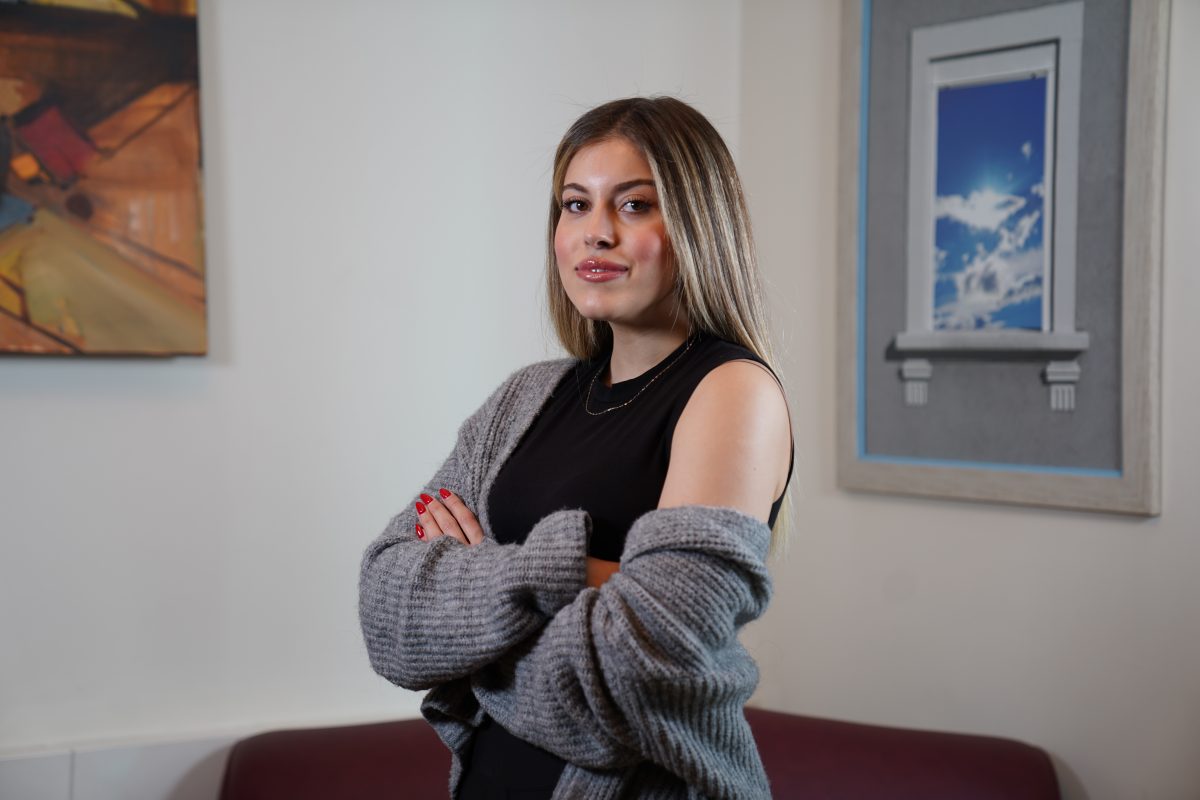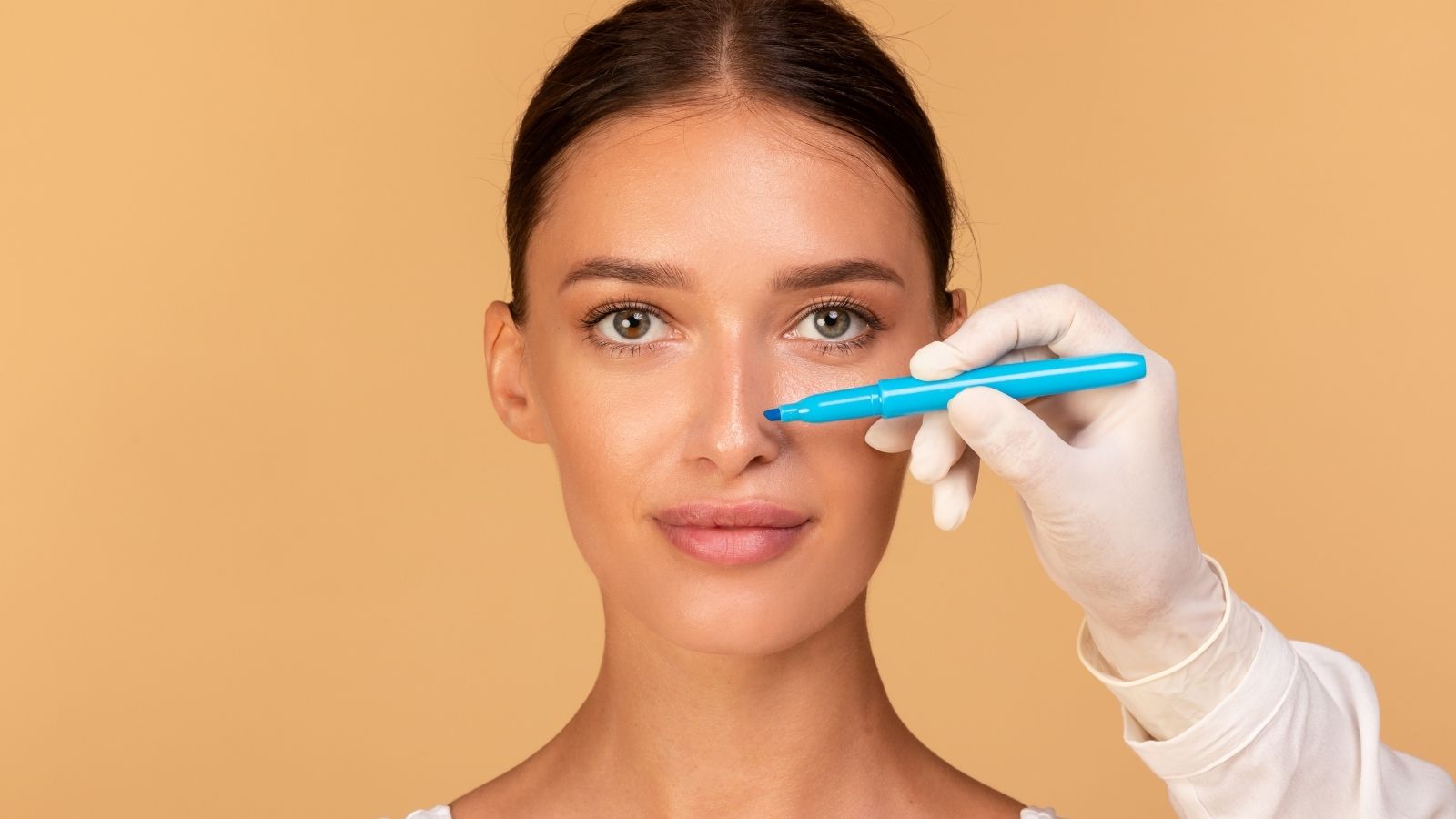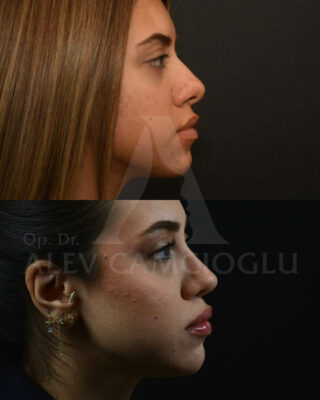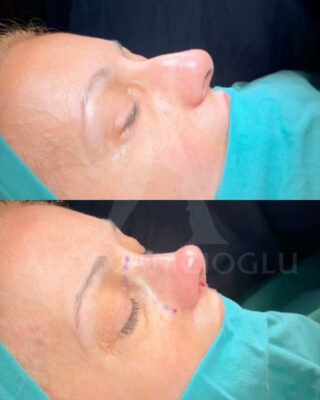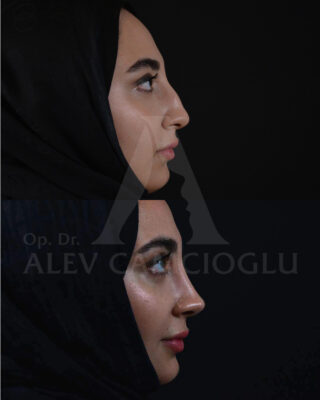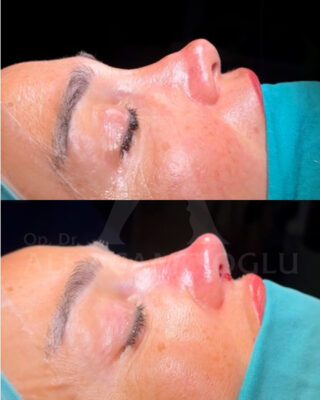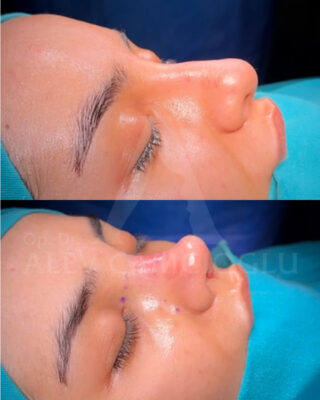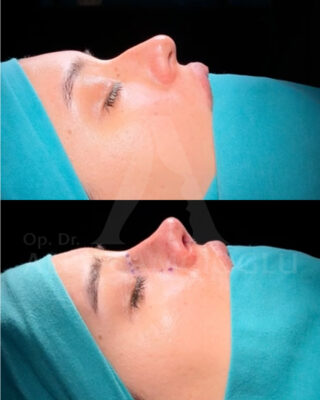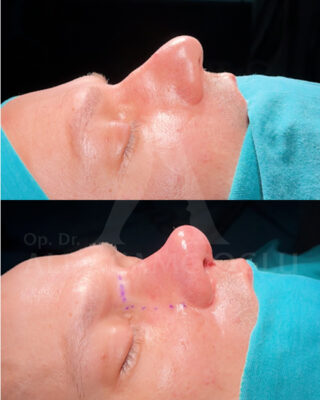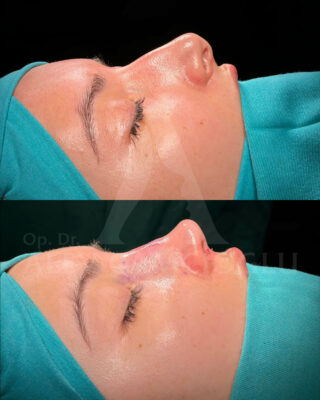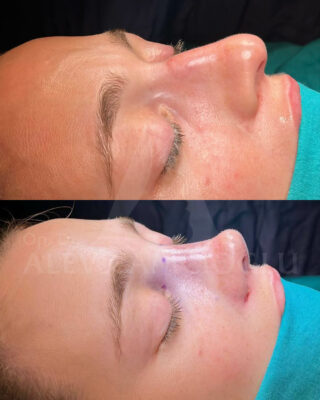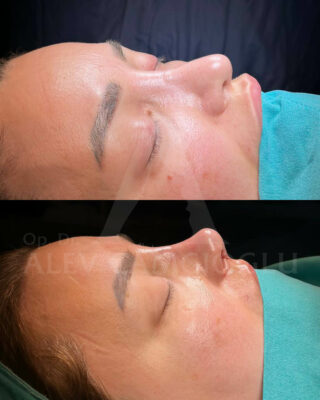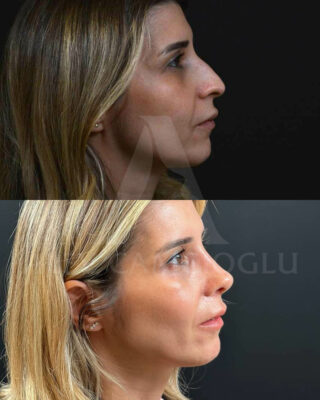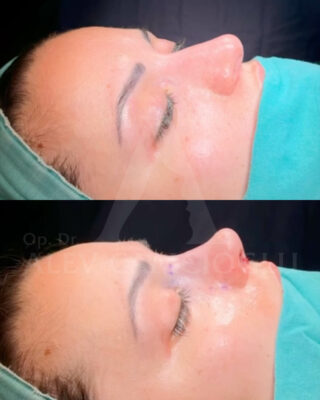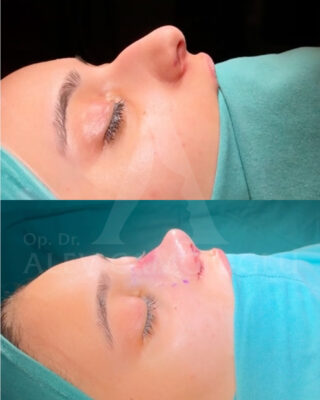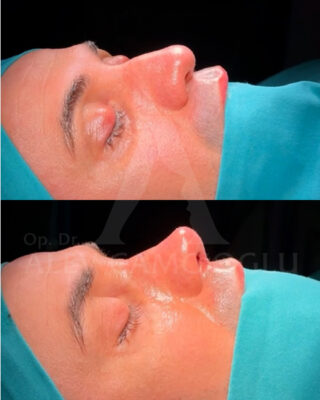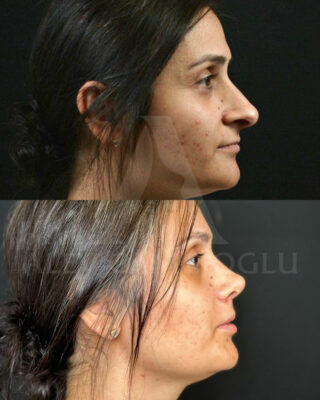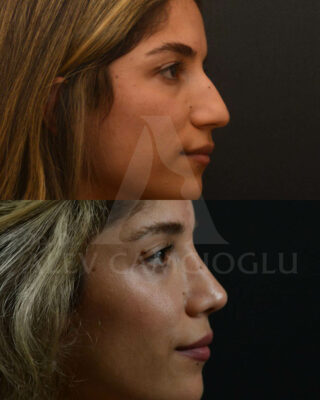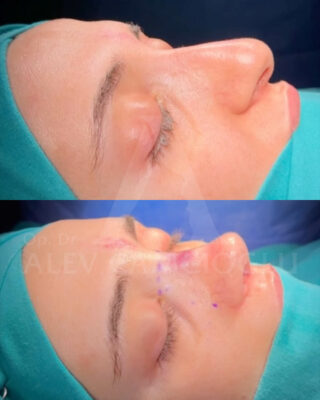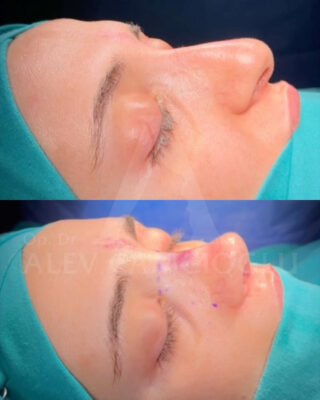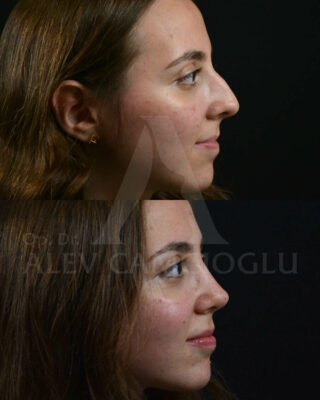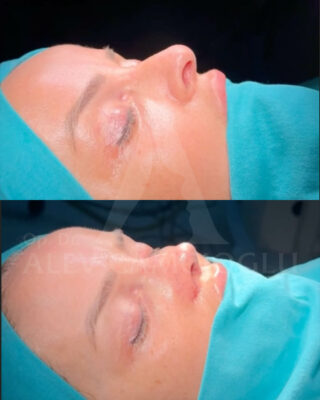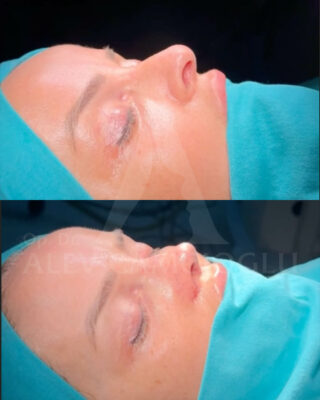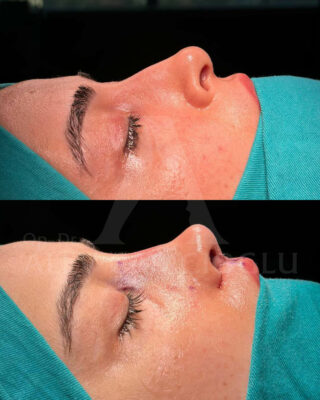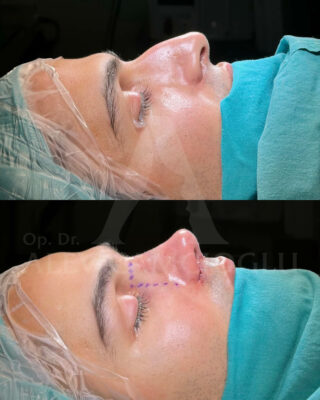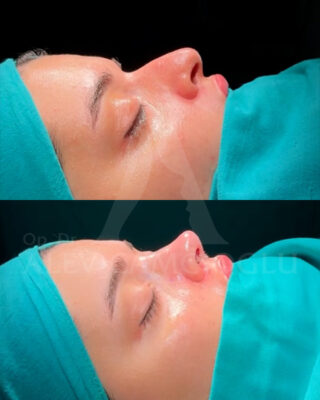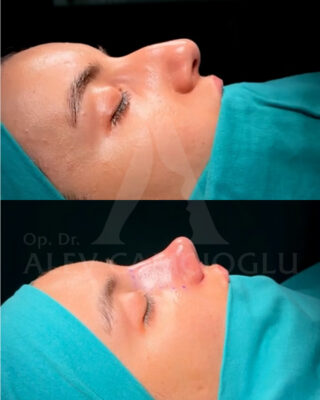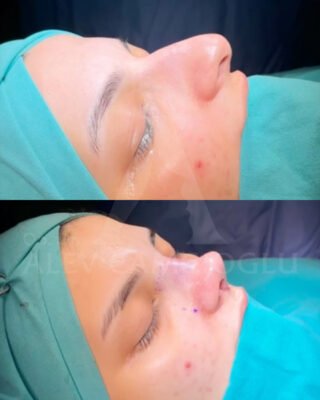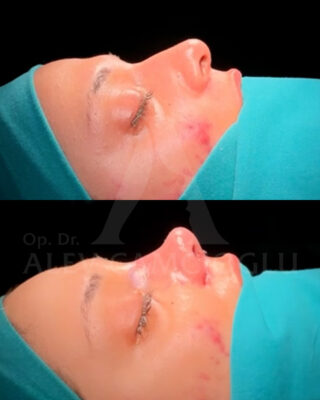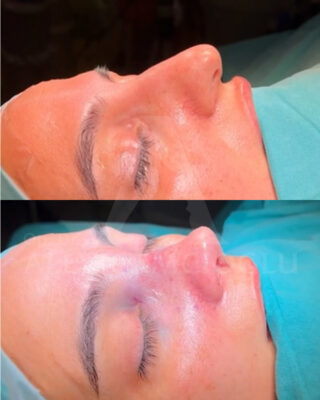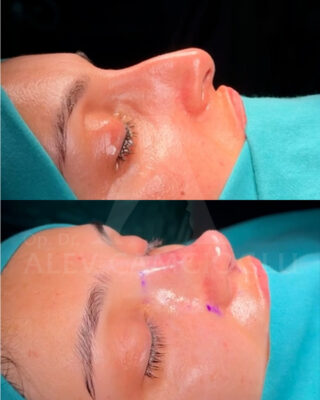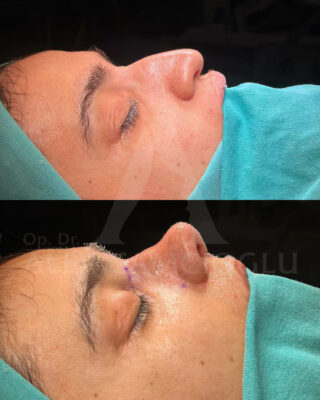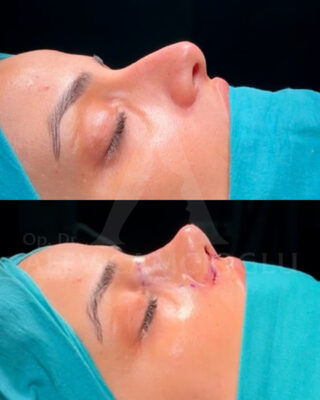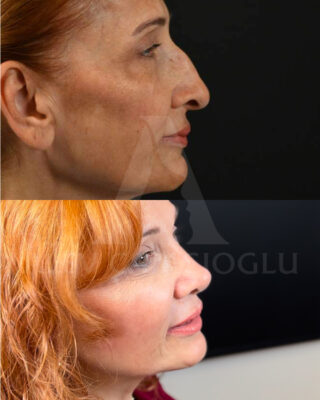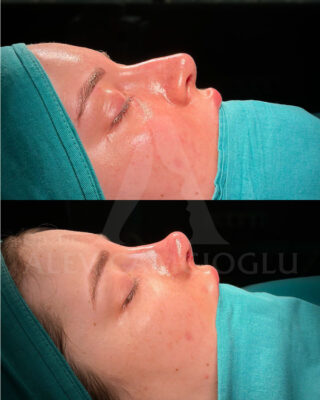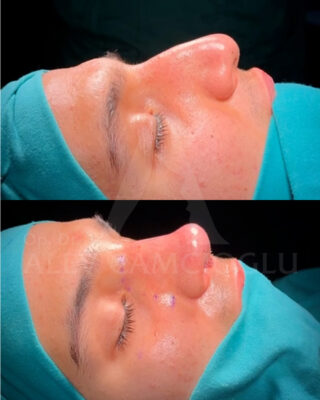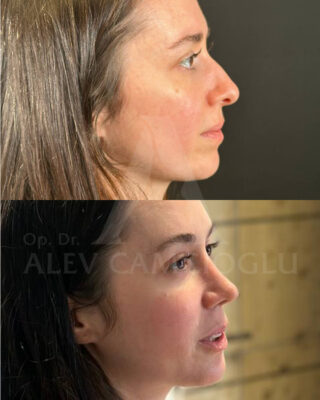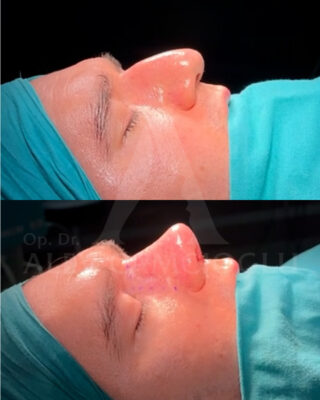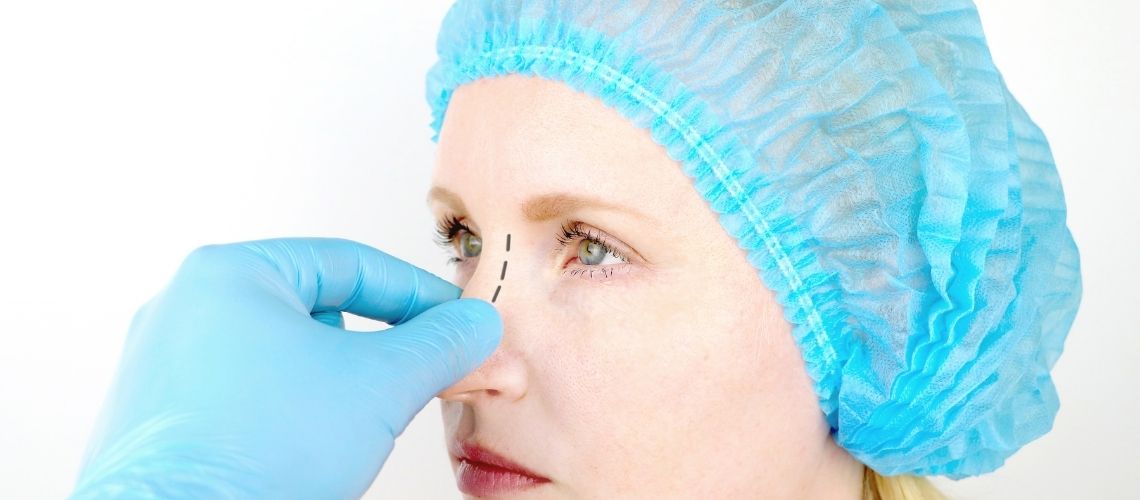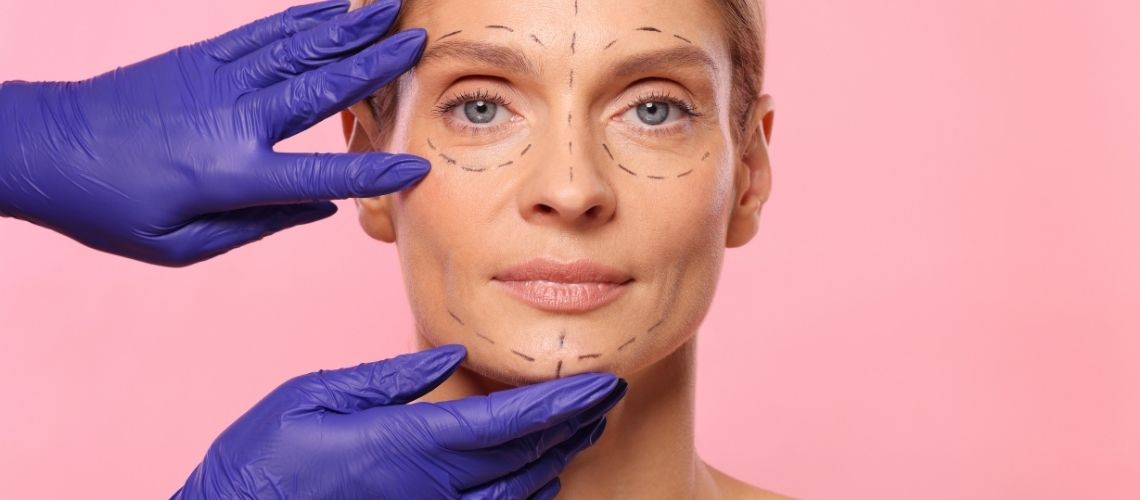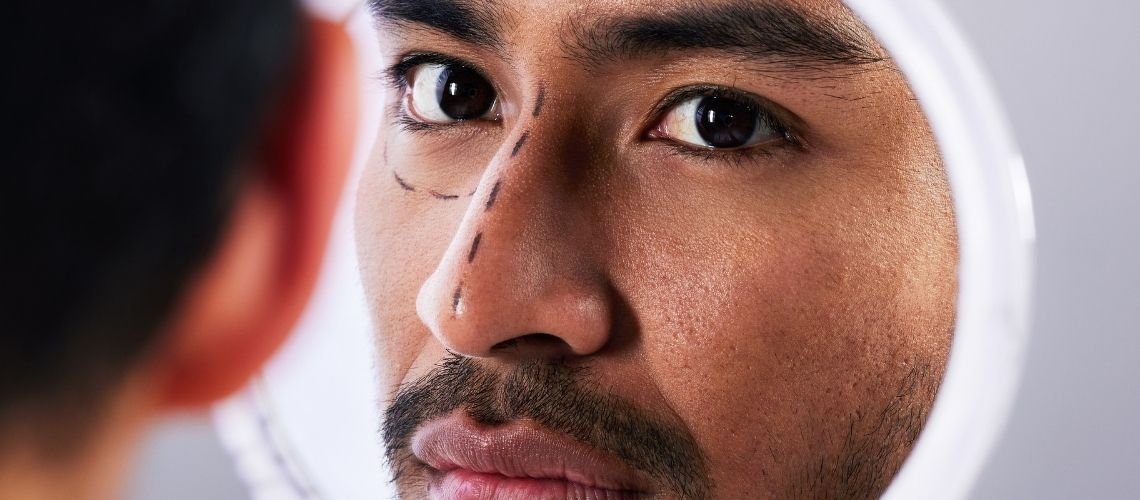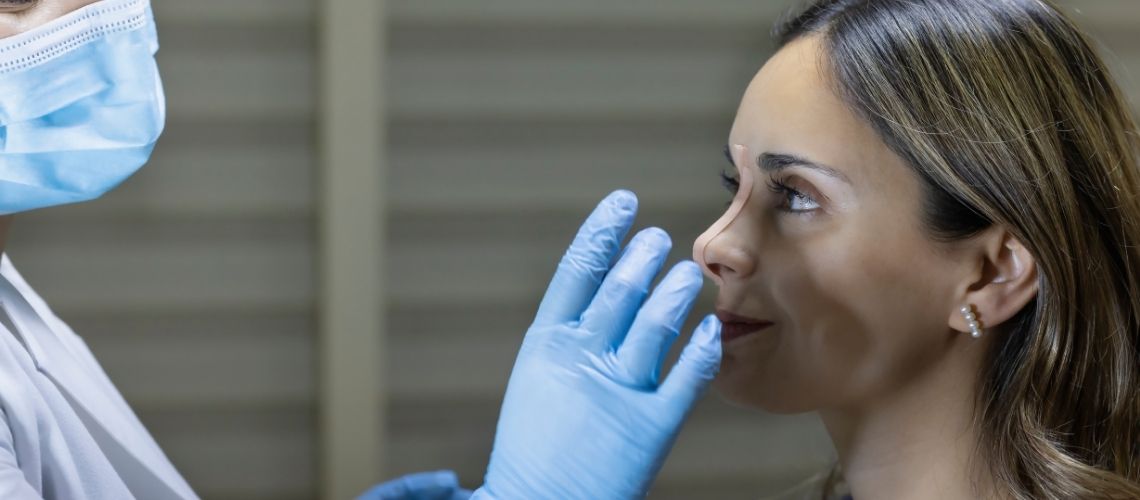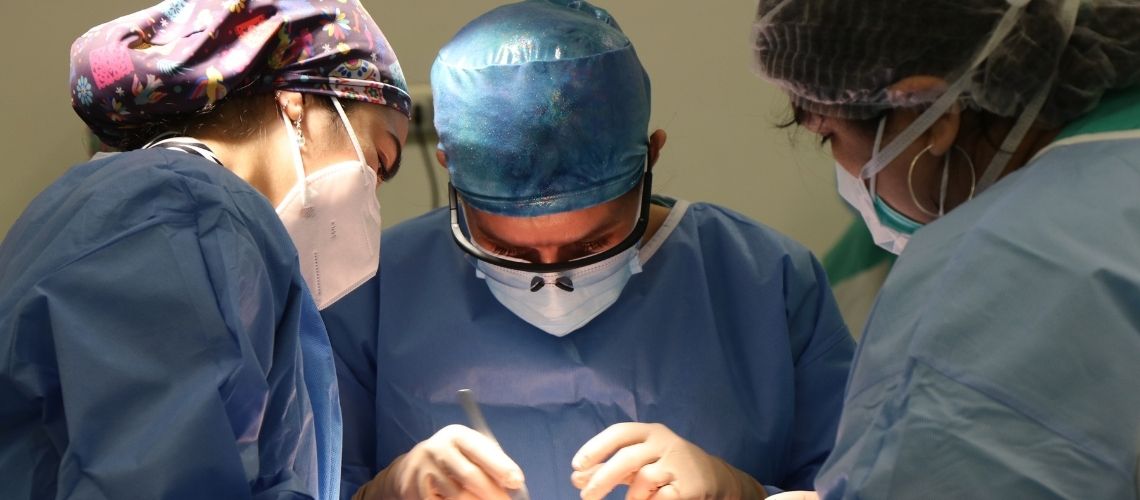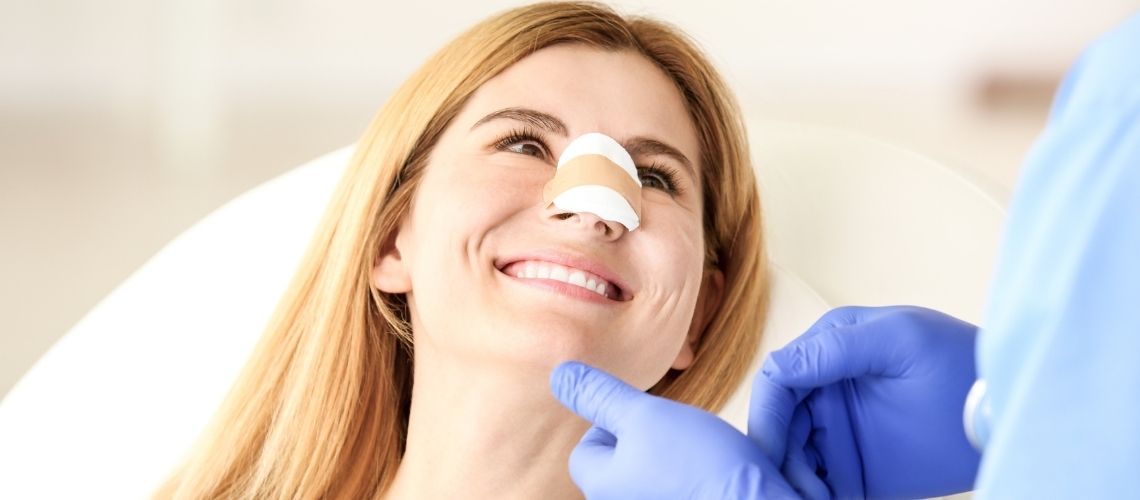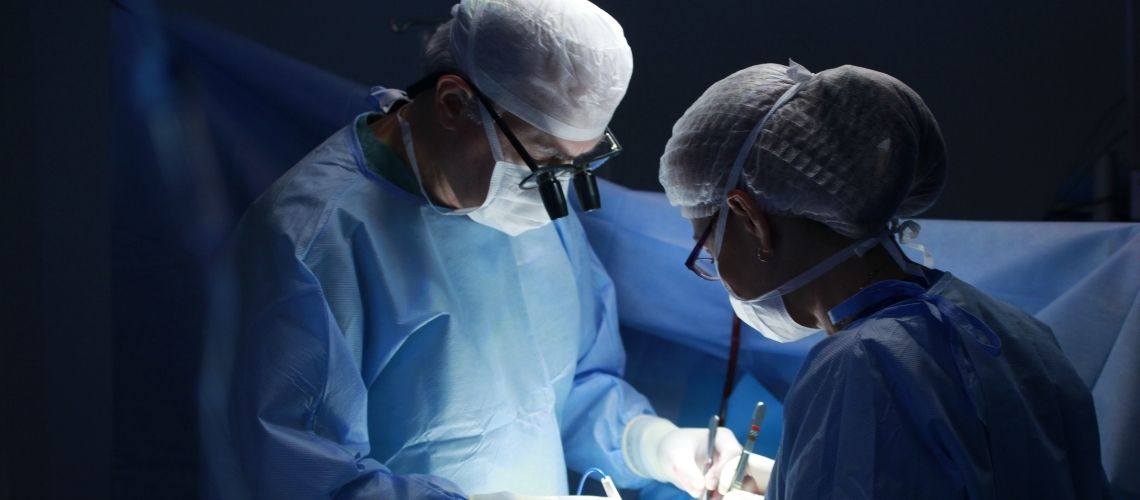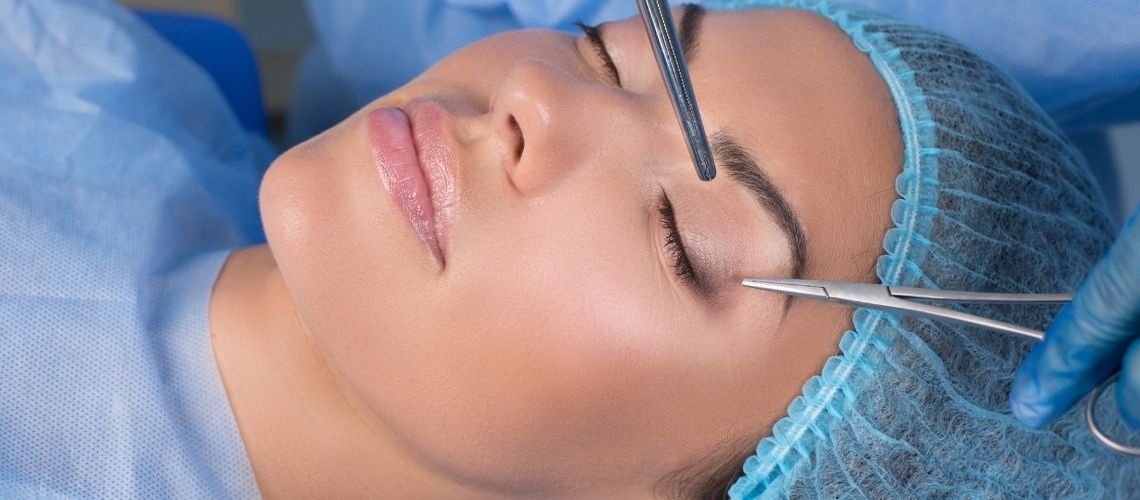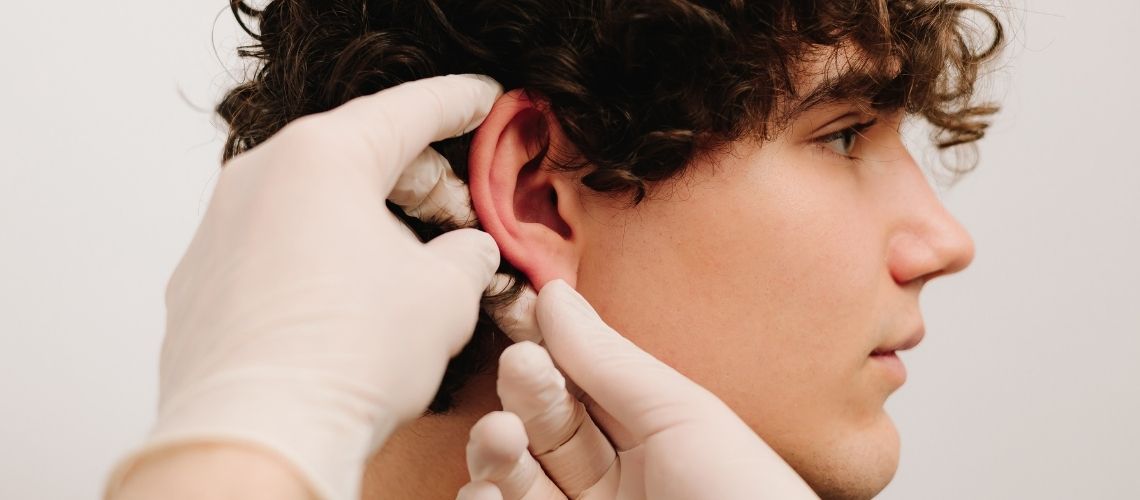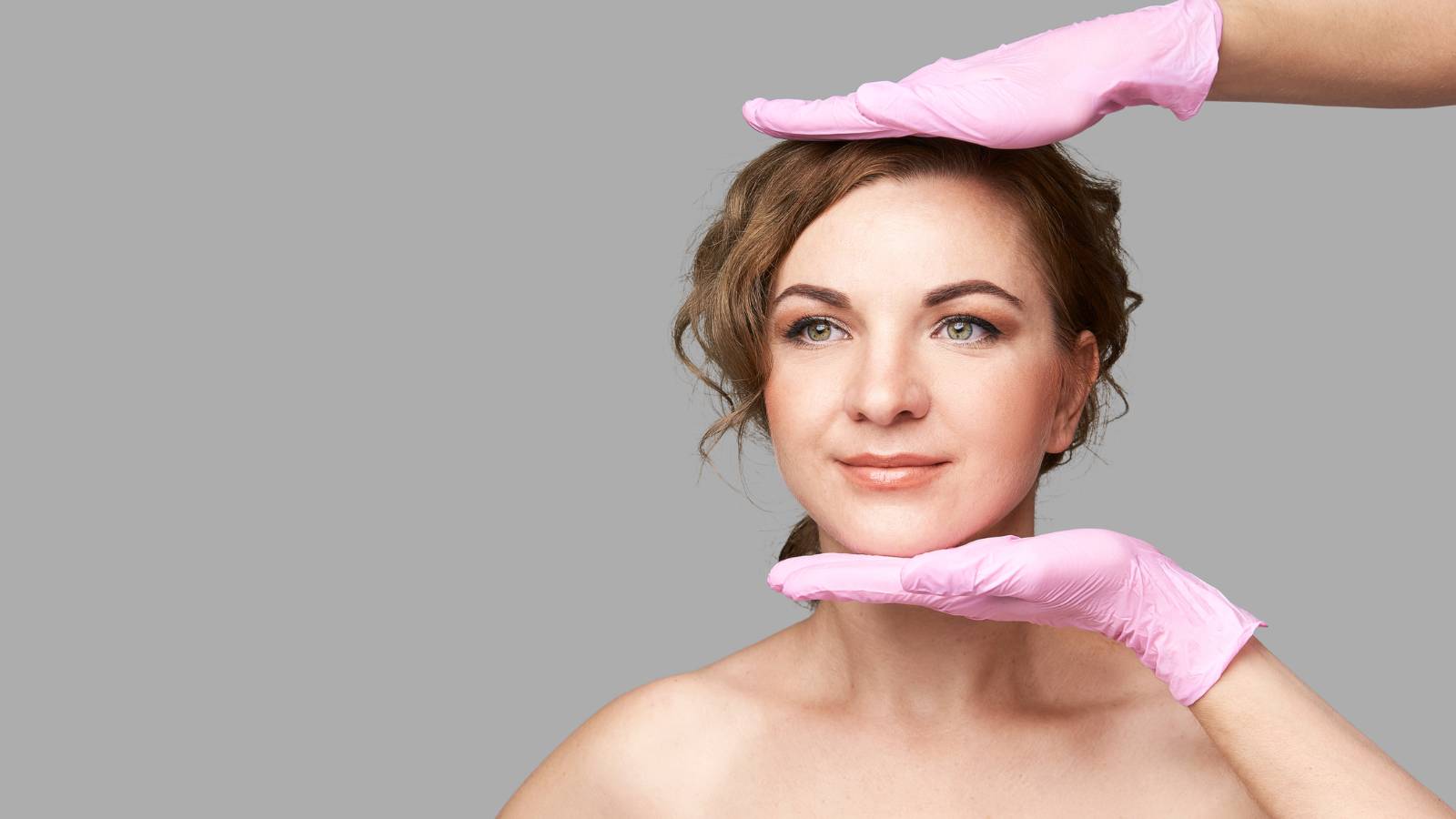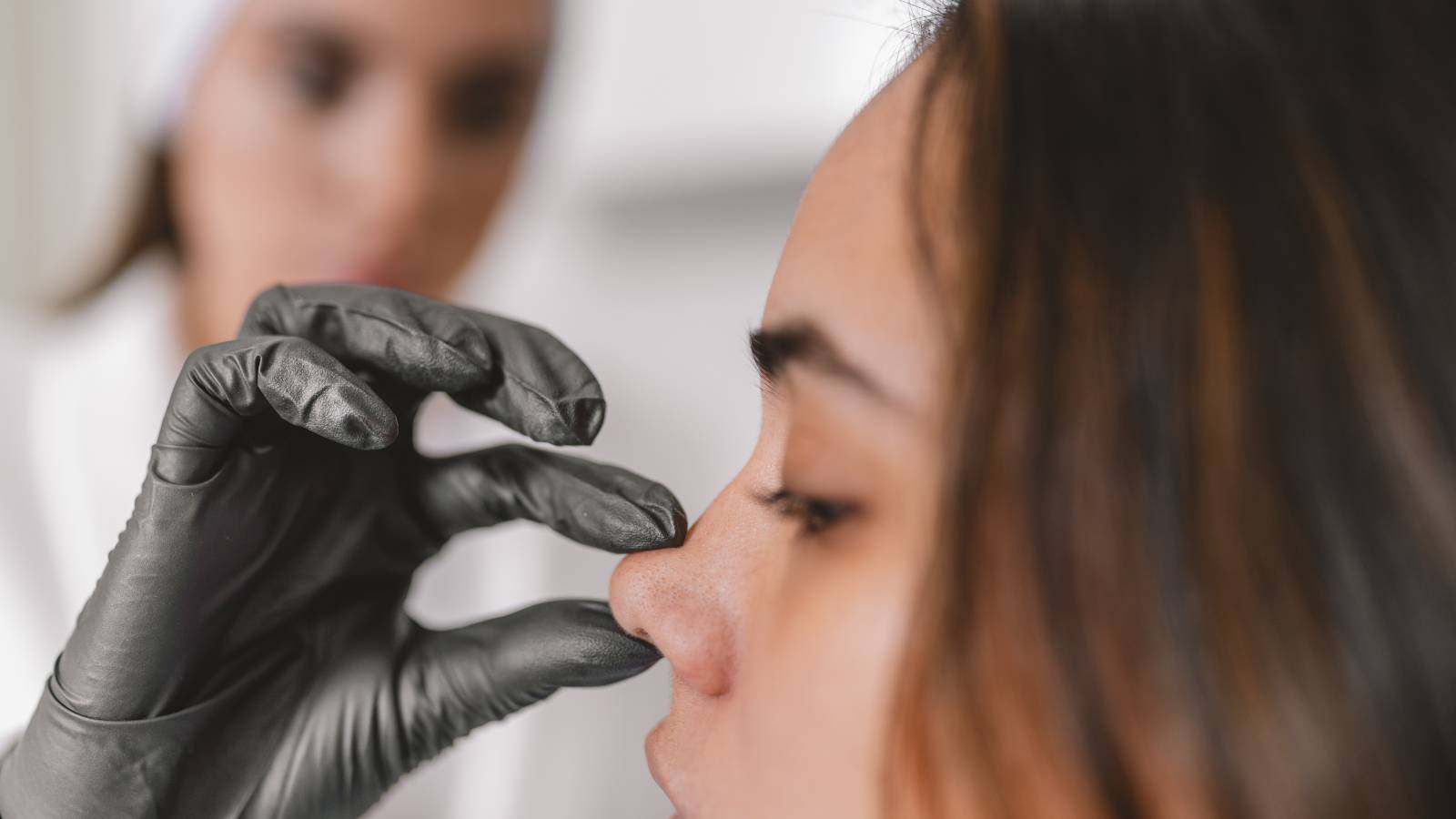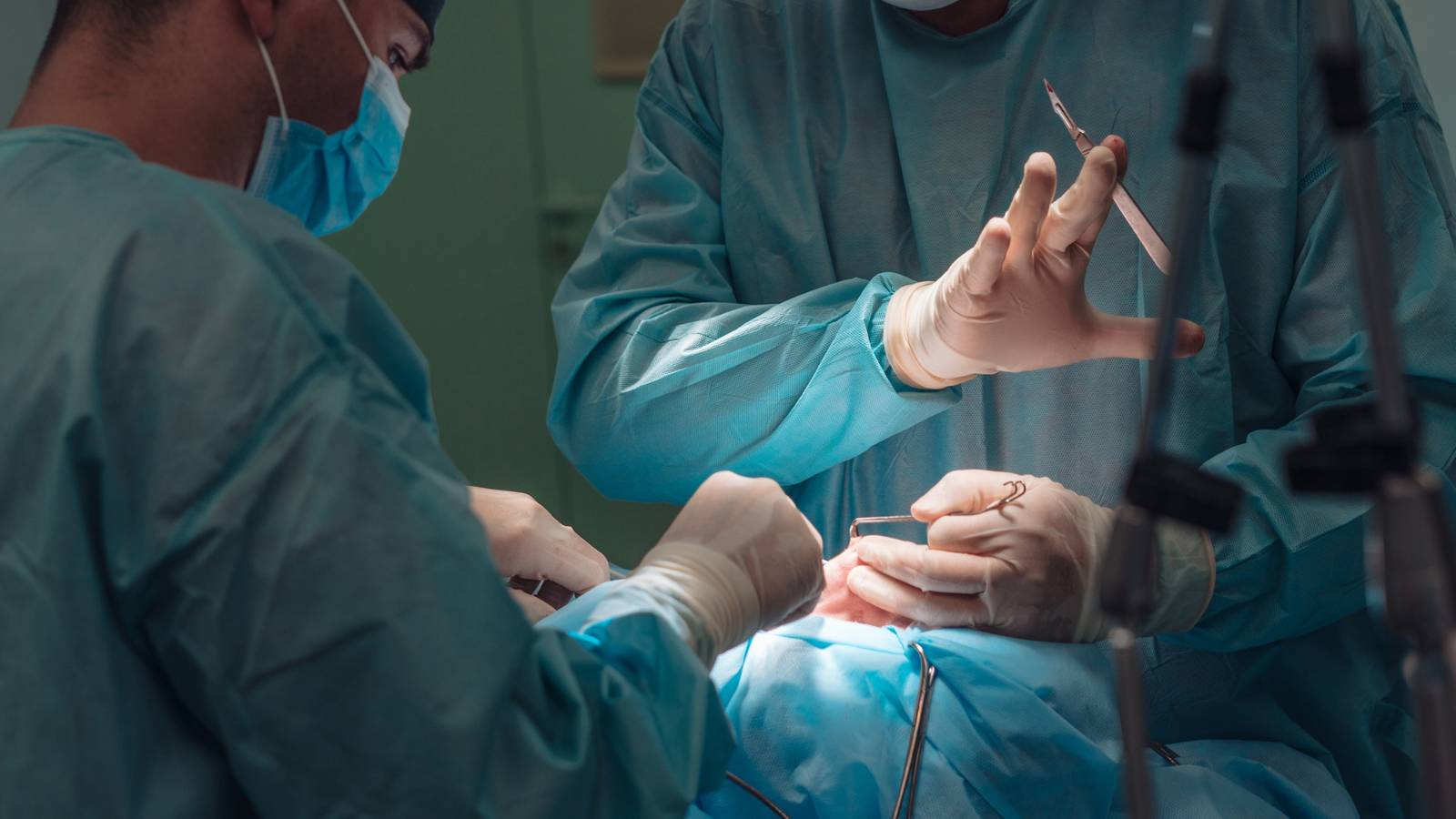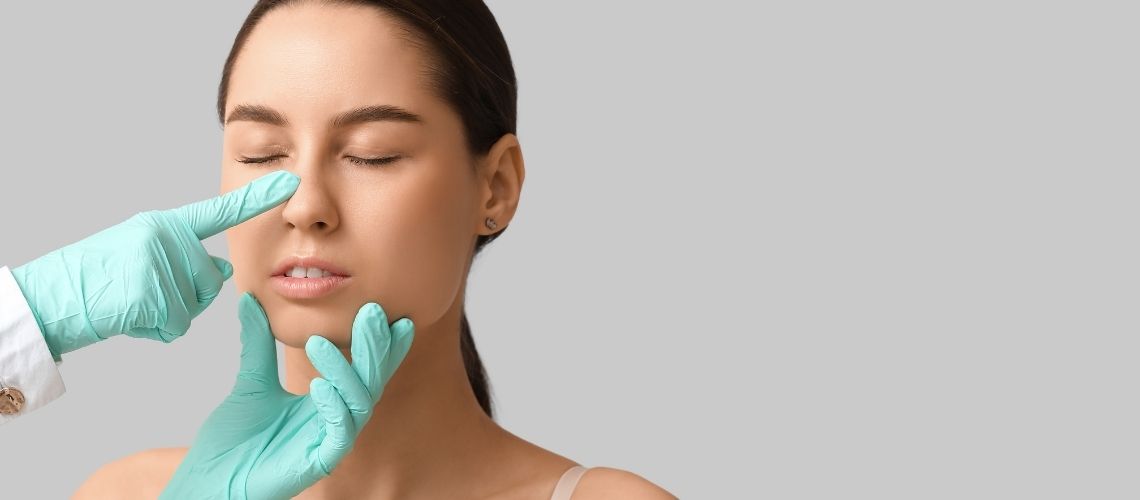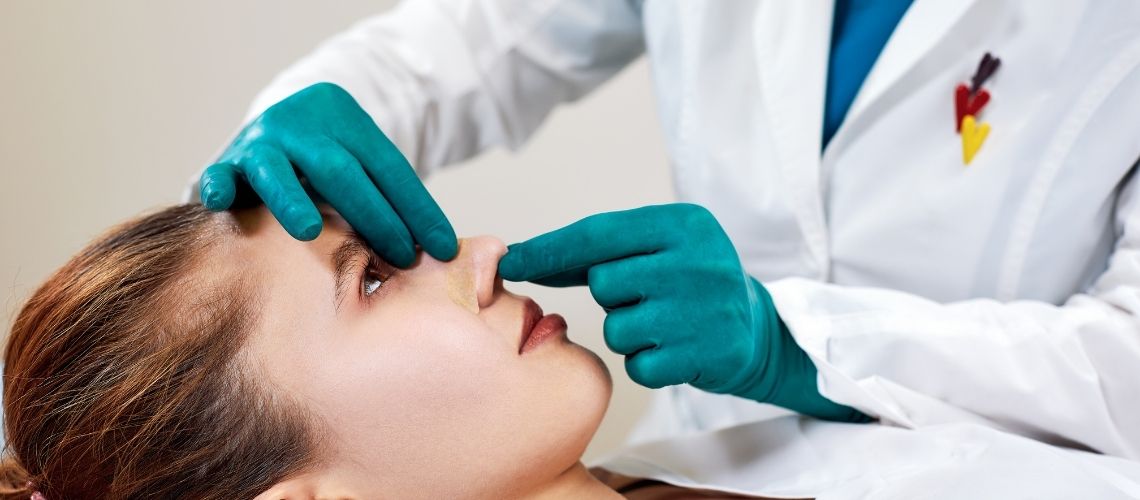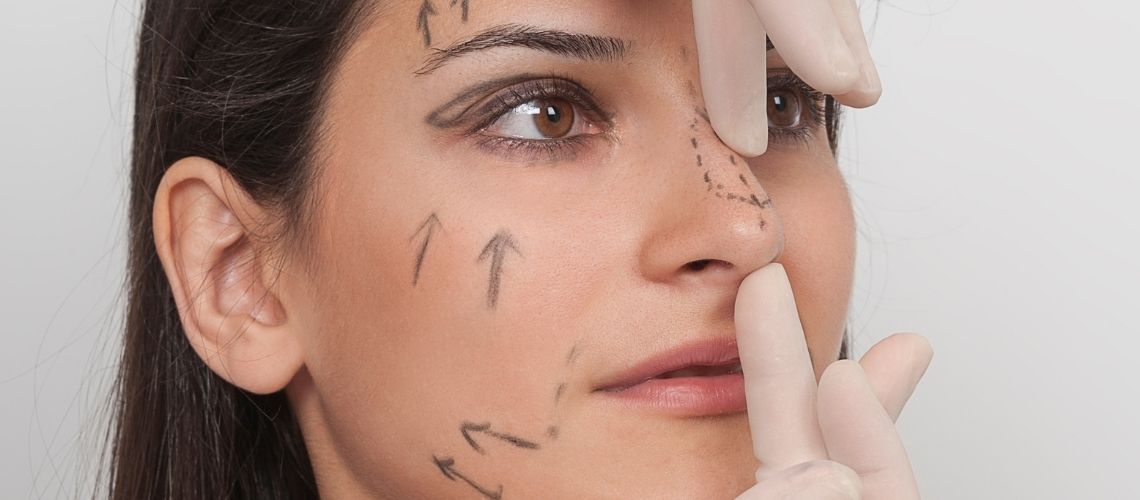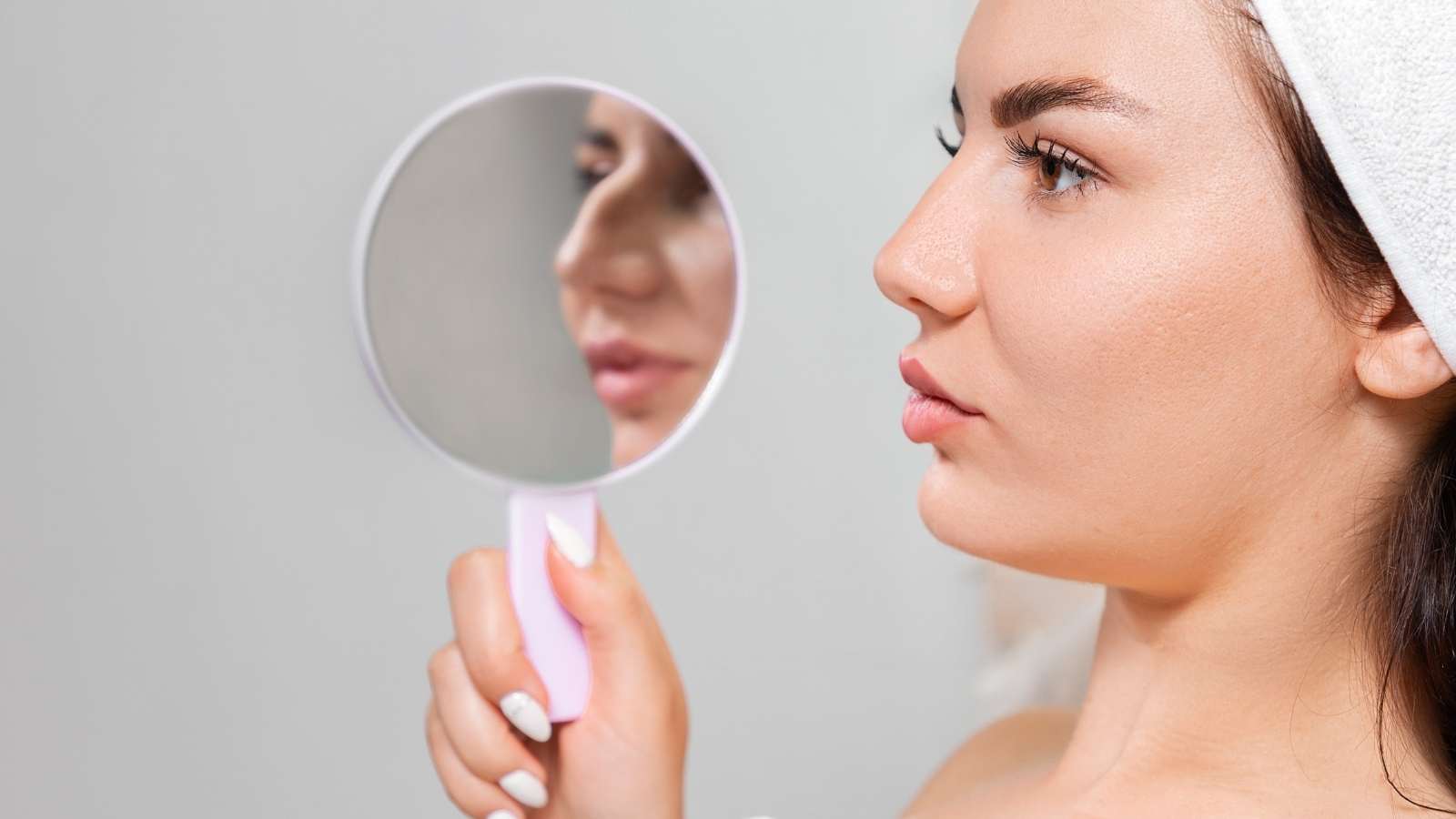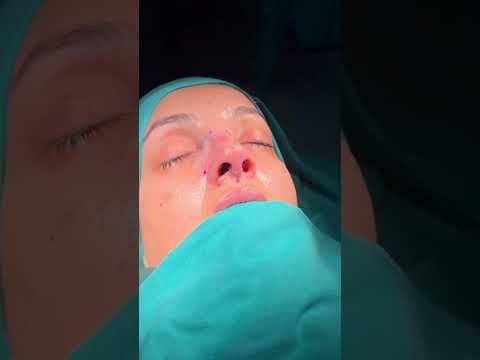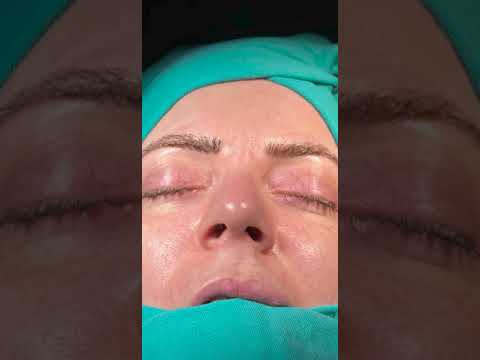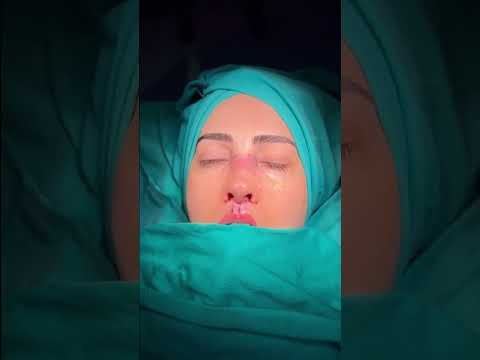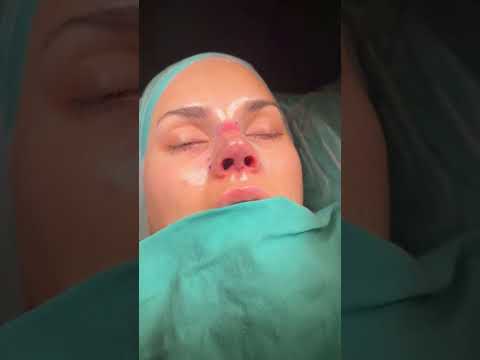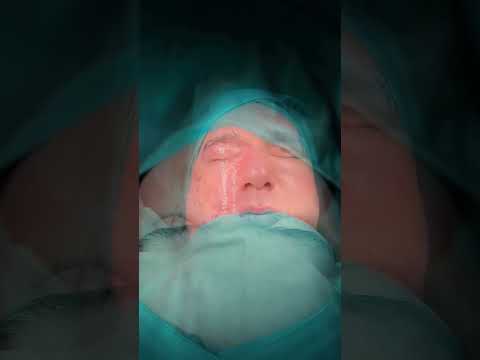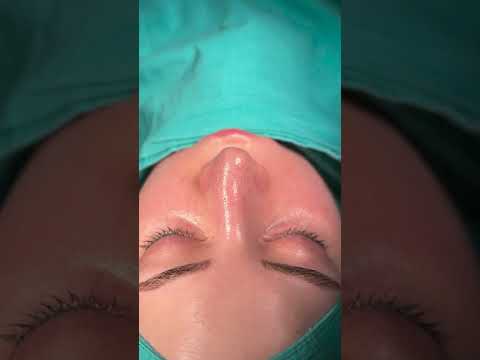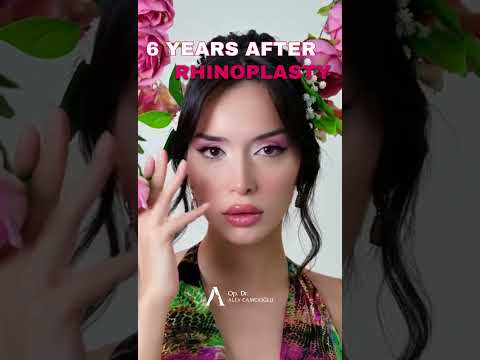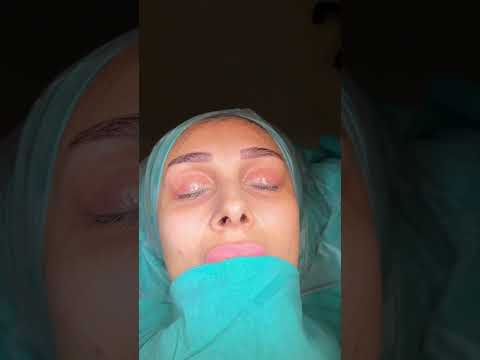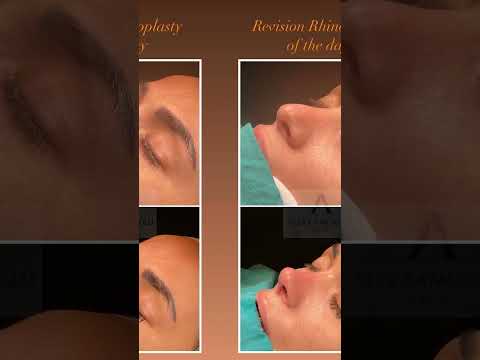Open Rhinoplasty in Turkey
At Dr. Alev Camcıoğlu’s clinic, we offer Open Rhinoplasty in Turkey for patients seeking comprehensive nasal reshaping. This technique allows Dr. Camcıoğlu to make precise adjustments to the nasal structure, addressing complex issues with exceptional accuracy. Our commitment to patient satisfaction means you’ll receive individualized care tailored to your unique needs and aesthetic goals.
Cost of Open Rhinoplasty in Istanbul, Turkey ranges between €5,000– €7,000 in 2025 depending on hospital, package, and anatomy of your nose. Check our prices, before & after photos, and patient results from the USA, UK, Canada, Australia, and the rest of the world.
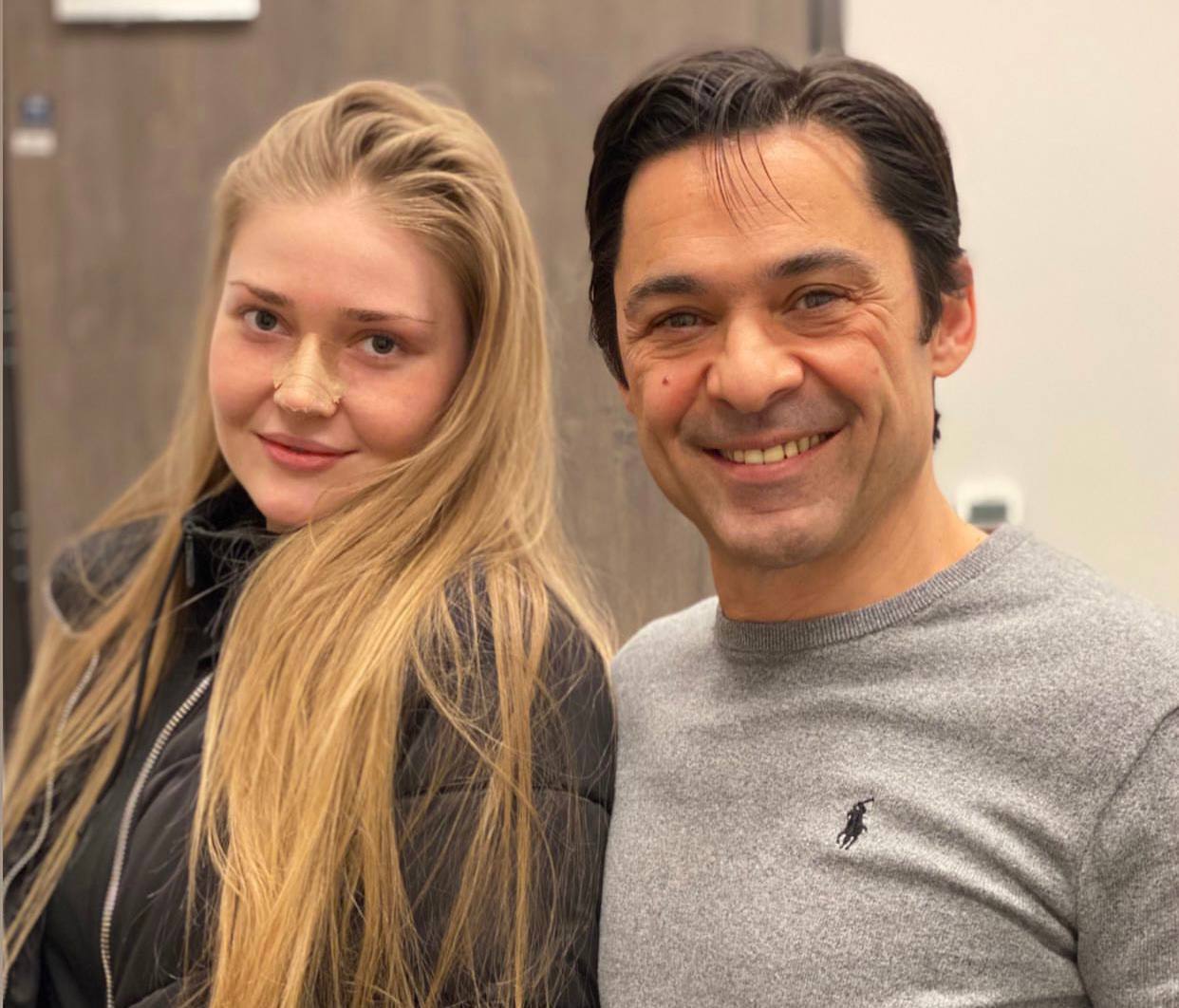
What Are the Advantages of the Open Rhinoplasty Technique?
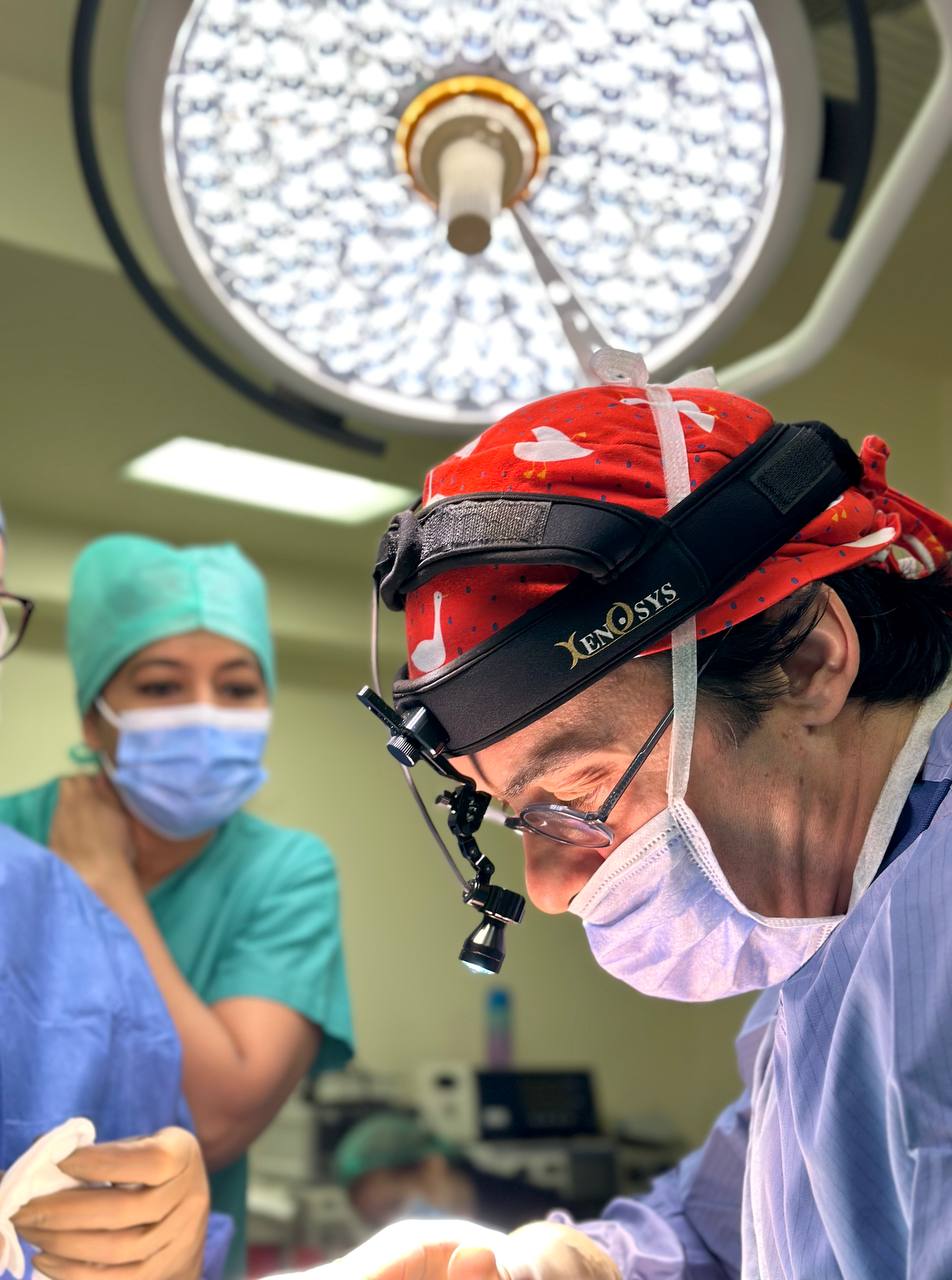
Open rhinoplasty is considered one of the most effective methods in nasal surgery. With this technique, surgeons can see the nasal anatomy more clearly and work more precisely in complex interventions. Additionally, open rhinoplasty allows for a thorough evaluation of the internal nasal structures. Here are some distinct advantages of this method:
- It provides better visualization, thus helping the surgeon move more controlled during the procedure.
- It offers more opportunities to correct complex nasal deformities.
- It increases the chances of achieving the expected results after surgery.
- It provides more definitive solutions for improving both the nasal functions and the aesthetic appearance of the patient.
This technique requires a deep understanding in the planning and implementation processes of surgery. The surgeon can shape the treatment according to the unique needs of each patient. Consequently, open rhinoplasty has the potential to achieve superior results both functionally and aesthetically.
What Are the Types of Open Rhinoplasty?
Open rhinoplasty involves a small incision at the columella to lift the nasal skin and provide full access to underlying structures. It is preferred for complex corrections and detailed reshaping. The main types include:
- Structural Open Rhinoplasty
- Reduction Open Rhinoplasty
- Augmentation Open Rhinoplasty
- Functional Open Rhinoplasty
- Revision Open Rhinoplasty
6 Reasons to Get Open Rhinoplasty in Istanbul



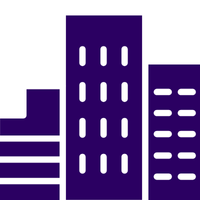


Post-OP
Care
Open Rhinoplasty Before & After Photos in Turkey
What Should Be Known About the Anatomy and Physiology of Open Rhinoplasty?
Success in open rhinoplasty depends on a detailed understanding of the nasal anatomy and physiology. Surgical intervention is performed to meet both aesthetic and functional needs. Each component of the nasal structure is important in this process.
- Ala: The lower lateral cartilages form the lower lateral surface of the nostril.
- Alar groove: The surface depression between the lower lateral crus and ala.
- Anterior septal angle: The angle formed by the dorsal and caudal septum.
- Columella: The skin area between the nostrils, between the tip and base of the nose.
- Dome: The anterior projection of the nose formed by the convergence of the medial and lateral crura.
- Dorsum: The midline ridge between the tip and nasion of the nose.
- External nasal valve: Defines the opening of the nostril, including the rim, columella, and nasal sill.
- Internal nasal valve: The point of airway resistance formed by the upper lateral cartilage, the head of the inferior turbinate, and the nasal septum.
- Keystone area: The junction where the perpendicular plate of the ethmoid and the cartilaginous septum meet the nasal dorsum.
- Lower lateral cartilages (LLC): Paired alar cartilages that include the medial, middle, and lateral crura.
- Nasion: The depression marked by the nasofrontal suture.
- Nasolabial angle: The angle between the long axis of the nostril and a perpendicular line to the Frankfurt horizontal plane.
- Radix: The junction of the nasal and frontal bones, ideally located at the level of the supratarsal crease.
- Rhinion: The superficial location of the bony-cartilaginous junction along the nasal dorsum.
- Scroll area: The junction of the cephalic lower lateral crus and the caudal upper lateral cartilage.
- Supratip area: The area cephalad to where the caudal nasal dorsum meets the tip.
- Tip-defining point (TDP): The most anterior projection of the tip that produces a light reflex in the frontal view.
- Tip projection: The distance from the TDP to the alar-facial groove. Various methods are available to measure tip projection.
- Tip rotation: The cephalad or caudad movement of the TDP around a pivot at the alar base.
- Upper lateral cartilages (ULC): Paired cephalad cartilages that form the side walls of the middle vault beneath the caudal nasal bone.
In Which Cases Is Open Rhinoplasty Preferred?
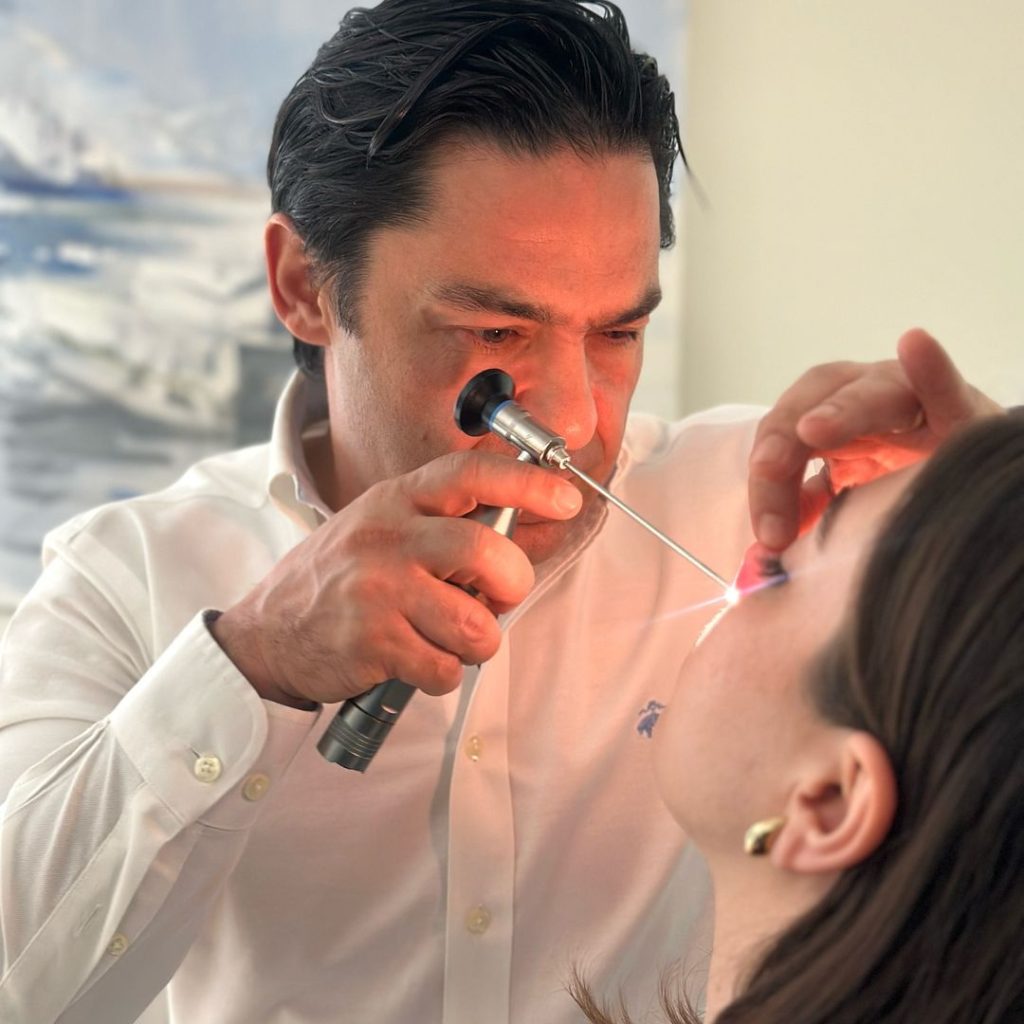
Open rhinoplasty is a preferred method for various conditions encountered in nasal surgery. This technique is particularly suitable for correcting complex nasal deformities. Detailed corrections can be made since the surgeon has full access to the nasal structure. Additionally, certain conditions create ideal scenarios for open rhinoplasty:
- Deep nasal root deformities,
- Asymmetric nasal structures,
- Complex scar tissues remaining from previous surgeries.
Open rhinoplasty also offers advantages in surgical training. The broad view of the surgical field allows new surgeons to better understand the procedure. Thus, the transfer of experience within the team happens more effectively. Patients can benefit from safer and more successful procedures performed by an experienced team.
Considerations in Open Rhinoplasty
Open Rhinoplasty is a method preferred especially in cases requiring extensive corrections. However, certain conditions may make this procedure risky or inappropriate. These conditions are primarily related to the patient’s current health status and medical history.
Among the points that need special attention are potentially increased edema and prolonged surgical duration. During this process, complications such as cartilage imbalance or external scars may develop. These effects can negatively impact the patient’s recovery process.
Certain components need to be evaluated before starting rhinoplasty, based on the patient’s history:
- Existing allergic disorders
- Vasomotor rhinitis
- Past nasal traumas
- Previous nasal procedures
- Respiratory problems, such as asthma or cystic fibrosis
- Sinus pathology
Additionally, illegal intranasal drug use can increase the complexity of the rhinoplasty procedure and jeopardize the postoperative outcome.
Special attention is also required for patients at risk of postoperative bleeding or septal hematoma. These patients may be taking the following medications:
- Anticoagulants
- Antiplatelet agents
- Nonsteroidal anti-inflammatory drugs
- Herbal medicines and supplements:
- Chondroitin
- Ephedra products
- Echinacea
- Glucosamine
- Ginkgo biloba
- Goldenseal
- Milk thistle
- Ginseng
- Kava
- Garlic
Poorly controlled hypertension before and during surgery can also increase surgical risks. Patients with Body Dysmorphic Disorder (BDD) may often be dissatisfied with the results after surgery and may show higher aggression towards surgeons. BDD is the condition where a person is obsessively preoccupied with perceived or minor flaws that are usually not apparent to others. This condition is more commonly seen in patients seeking facial aesthetics.
What Equipment Is Required for Open Rhinoplasty?
The equipment used in open rhinoplastys operations plays a significant role in the success of the procedure. Various solutions are used in the preparation phase for local anesthesia. These solutions include a mixture of lidocaine and epinephrine and bupivacaine and epinephrine. Oxymetazoline-containing nasal spray and povidone-iodine are used to reduce nasal congestion and for antiseptic purposes. A shoulder roll is placed to ensure the patient stays in the correct position.
Anesthesia:
- %1 Lidocaine and %1 Epinephrine mixture (1:100000)
- %0.5 Bupivacaine and %1 Epinephrine mixture (1:200000)
Nasal openers:
- Nasal tampons soaked with oxymetazoline
Antiseptics:
- Povidone iodine
Patient positioning:
- Shoulder roll
Various instruments come into play during the surgical procedure. Headlight is used as a light source, scalpels for incisions, and scissors of various sizes. Fine instruments like Adson-Brown and bayonet forceps are preferred for cartilage shaping with a septum morselizer. Additionally, retractors and speculums are indispensable for better viewing the nasal structure.
Surgical instruments:
- Headlight, scalpels (No. 11 and 15), Iris and Converse scissors
- Forceps: Adson-Brown, bayonet
- Septum morselizer
- Nasal retractors: Converse, Aufricht
- Skin hooks: 5 mm and 10 mm
For postoperative care, antibiotic ointment, adhesive tape, and specially made nasal splints are used. A mustache dressing and nasal tampons are provided for patient comfort. These materials support the healing process and minimize postoperative complications.
Postoperative materials:
- Antibiotic ointment
- Adhesive tape
- Nasal splint: Thermoplastic splint
- Septal splints: Special silicone plates
- “Mustache” dressing: 4×4 gauze roll
- Nasal tampon: Rolled non-stick gauze
What Are the Preparations for Open Rhinoplasty?
Preparations before an open rhinoplasty operation are of vital importance for a successful result. The first step is to evaluate the patient’s medical condition and obtain permission for surgery. During this process, risk classification is done, and the patient’s condition is optimized for surgery. Another important step is the pre-operative photography. Photos showing the patient’s facial structure from different angles are taken:
- Frontal view
- Three-quarter view
- Profile view
- Worm’s-eye view
- Bird’s-eye view
These photos document the nasal position, facial asymmetries, and the impact of the smile on the nose in detail. Using digital imaging software, surgical results can be visually presented to the patient. This allows for clear communication between the patient and the surgeon and helps form realistic expectations.
On the day of surgery, the surgical marking phase is started. An inverted V-shaped mark is made on the columella to make the scar less visible. If necessary, markings for osteotomy and alar base reduction are also made. A single dose of intravenous antibiotics is administered to reduce the risk of infection in the surgical area. Additionally, a single dose of steroid and tranexamic acid is given to control swelling and bleeding.
Local anesthesia is carefully applied to preserve the natural appearance of the nasal area. Additionally, nasal tampons soaked in solution are placed inside the nose to reduce bleeding and crusting during the operation. Vibrissae are trimmed to facilitate visualization in the postoperative period and speed up the healing process. All these preparations maximize the aesthetic and functional success of the open rhinoplasty operation.
Open Rhinoplasty Techniques and Procedures
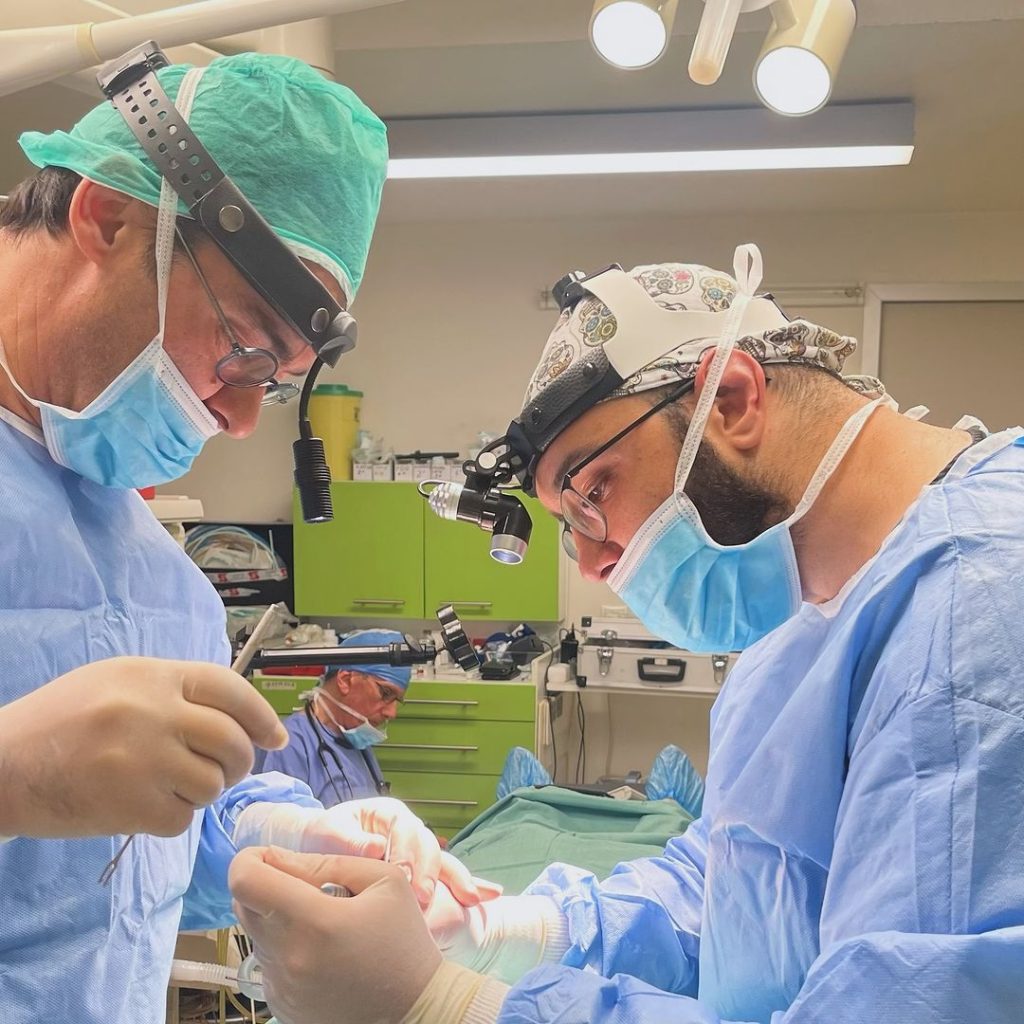
Open rhinoplasty offers comprehensive interventions related to the nasal structure. During the procedure, surgeons work with carefully planned incisions and reshaping techniques.
Nasal Opening Procedure
This process provides clear access to the nasal structure. The surgeon advances without damaging the cartilage under the nasal skin.
- An inverted V-shaped incision is made.
- The transition from the central columellar incision to the marginal incisions is carefully made.
- Soft tissue is reflected in an avascular plane to expose the upper lateral cartilages.
Septoplasty
During septoplasty, the nasal septum is corrected and airway patency is increased.
- The anterior septal angle is sharply revealed
- The septal bone and cartilage are examined up to the nasal spine
- Appropriate septal cartilage is identified for the placement of spreader grafts
Dorsal Hump Reduction
Reducing the dorsal hump helps to flatten the nasal dorsum.
- The bony hump is reduced using osteotomes and rasps.
- The cartilaginous dorsum is cut and smoothed without damage.
Spreader Grafts and Flaps
These maneuvers support the nasal valves and regulate the airway.
- Septal cartilage grafts are placed into sub-mucocondrial pockets.
- If ULC height is adequate, auto-spreaders can be preferred.
Nasal Tip Contouring
Shaping the nasal tip is performed with various techniques.
- Mastery of suture-based tip-plasty techniques is important.
- Cartilage grafts give shape and support to the tip.
Nasal Base Stabilization
Stabilization of the nasal base is performed before shaping the nasal tip.
- Columellar support is used if there are no changes in projection and rotation.
- If necessary, tongue-in-groove technique or caudal septal extension graft may be applied.
Dorsal Augmentation
The dorsal area is enhanced with various grafts.
- Radix graft or septal cartilage onlay grafts can be used.
- For large augmentations, cartilage is wrapped in temporalis fascia and placed.
Alar Rim Grafts
Grafts are placed to shape and enhance the function of the alar rims.
- Small onlay grafts are placed along the marginal incision.
- These grafts improve the function of the external valve by increasing the length and width of the nostril.
Alar Base Reduction
The alar base is reduced to appropriate dimensions.
- Limited skin excision is performed between the nasal sill and the ala.
- This reduction is applied when decreased tip projection creates an enlarged alar base appearance.
Osteotomies
Precise cuts are made to correct irregularities in the bony structure.
- Medial, intermediate, and lateral osteotomies are used.
Closure and Postoperative Care
The healing process after surgery begins with careful closure.
- A septal splint can be sutured in place.
- Marginal incisions are closed with sutures.
- Taping from the nasofrontal angle to the supratip is applied to reduce postoperative edema.
What Are the Main Complications Encountered in Open Rhinoplasty?
Complications that can occur after open rhinoplasty surgery can cause both aesthetic and functional problems. Rare major complications include hematoma, infection, pulmonary issues, and venous thromboembolism, usually seen in less than 0.7% of patients. More common complications are:
- Nasal bleeding
- Ecchymosis
- Edema
- Patient dissatisfaction due to persistent or new functional and/or cosmetic deficiencies
Specific cosmetic complications include:
- Tombstone deformity: Occurs when the nasal tip graft is too rigid and forms a noticeable structure under the soft tissue envelope.
- Rocker deformity: Arises when lateral osteotomies extend too far into the nasofrontal angle, causing the inferior nasal bones to medialize and the superior nasal bones to be pushed outward.
- Inverted-V deformity: Seen after hump reduction, caused by a lack of continuity between the upper lateral cartilages and nasal bones, forming a visible triangular shadow. This issue can be minimized by the routine placement of spreader grafts.
- Polly beak deformity: Characterized by a relative lack of projection of the lower third of the nose due to over-resection of the bony dorsum and under-resection of the cartilaginous dorsum.
- Ski-slope deformity: Results from excessive hump reduction, creating a very low nasal structure. This complication can be prevented by using cold compresses and frequent palpation of the soft tissue envelope during surgery.
- Saddle nose deformity: Caused by loss of septal support, leading to middle vault collapse, columellar retraction, excessive tip rotation, lack of tip projection, and nasal shortening. This can be prevented by preserving at least 1.5 cm of septal L-strut (dorsal and caudal septum).
- Nasal bossae: Caused by asymmetries in the cartilaginous framework, leading to a knuckle-like projection of the alar cartilages.
- Open roof deformity: Occurs due to greenstick/incomplete lateral osteotomies, resulting in a palpable or visible separation of the nasal bones.
These complications may require revision following open rhinoplasty procedures, but the need for revision in primary open rhinoplasty is only about 3%. Proper management and patient follow-up in the postoperative period can help minimize these types of complications.
Postoperative Care in Open Rhinoplasty: What Should Patients Do?
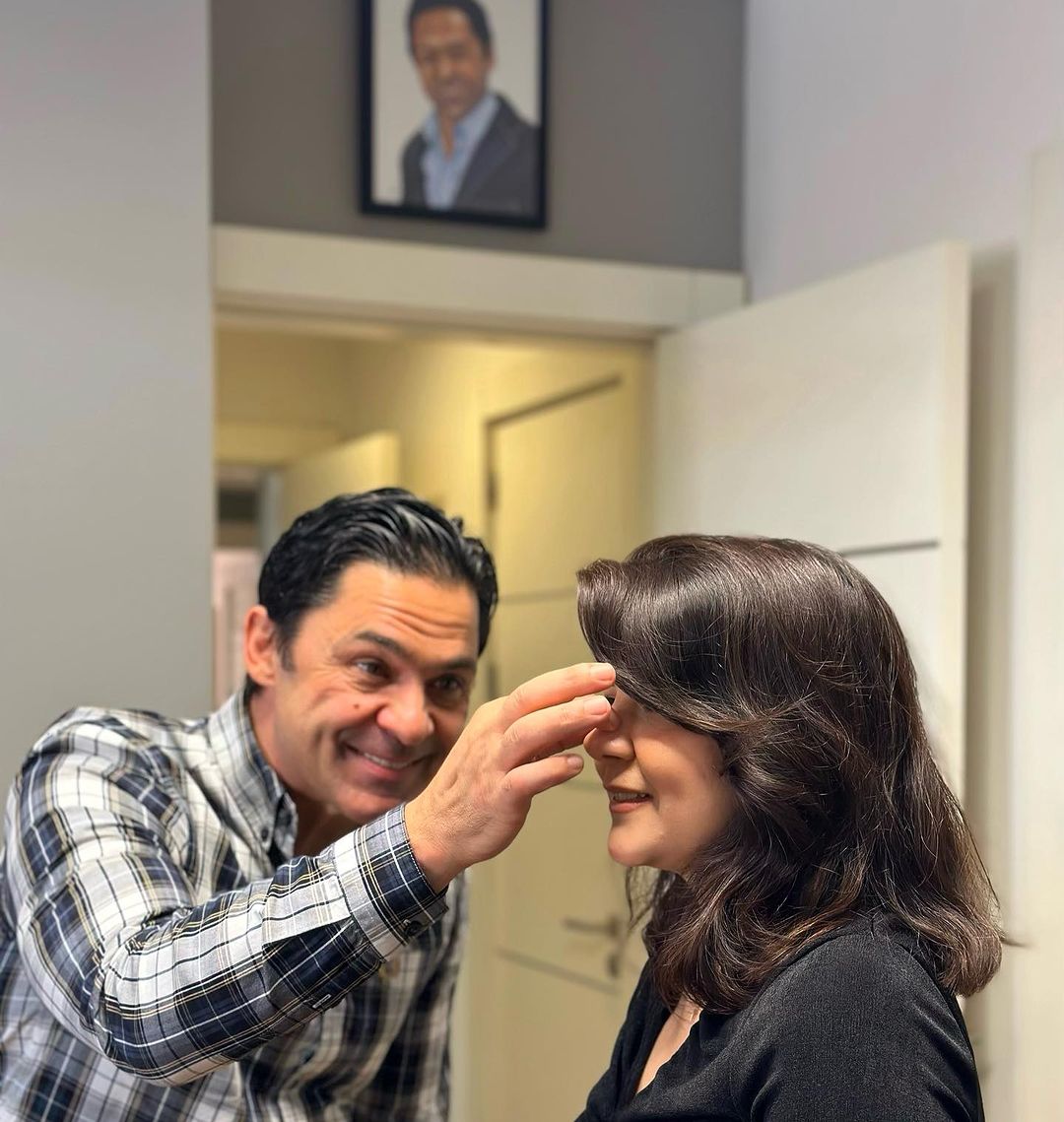
Postoperative care after open rhinoplasty is crucial for the success of the recovery process. The surgeon usually states that mild pain can be felt during the first three days after surgery and prescribes pain relievers for this period. Specific steps are recommended to speed up recovery and reduce discomfort:
- In the first 24 hours, ice should be applied intermittently to the bridge of the nose and eyes to reduce swelling and bruising.
- Keeping the head elevated during sleep is recommended for the first week.
- Strenuous physical activities should be avoided for the first two weeks.
As part of postoperative care, the doctor usually recommends low-dose corticosteroids to reduce bruising and swelling. The patient needs to come for a check-up on the seventh day to remove the stitches and cast. During this visit, “nasal massage exercises” to reduce swelling are advised. If there are still some irregularities in the nasal structure, the doctor may recommend continued nasal taping. The patient should avoid direct pressure on the nasal bridge, such as wearing glasses, for the first six weeks.
Postoperative follow-up visits are conducted six weeks and six months later to evaluate the recovery process. In this period, especially in patients with thick skin who have had extensive tip manipulation, edema may last for several weeks. If there is significant persistent swelling post-surgery, the patient may benefit from steroid injections. At the end of the recovery process, approximately 12 months later, the patient’s condition is documented with photographs.
How Much Does a Open Rhinoplasty in Turkey in 2025 ?
The cost of a Open Rhinoplasty in Istanbul, Turkey, typically ranges between €5,000 and €7,000. The price can vary depending on several factors, such as the surgeon's experience, the complexity of the procedure, the clinic's reputation, and additional services included in the package.
| Average Open Rhinoplasty Cost (in Euros) in 2025 | |
| United Kingdom | €16,600 – €19,000 |
| United States | €14,200 – €23,400 |
| Canada | €16,000 – €19,000 |
| Australia | €23,800 – €37,800 |
| South Korea | €9,400 – €17,200 |
| Ireland | €13,000 – €15,000 |
| Germany | €11,000 – €13,000 |
| Netherlands | €11,000 – €13,000 |
| France | €11,000 – €13,000 |
| Turkey | €5,000– €7,000 |
Frequently Asked Questions
How long does open nose surgery take?
The duration of open nose surgery is usually around 2 hours. However, this duration can vary depending on the patient’s condition and the complexity of the procedures to be performed. For example, if there are more challenging conditions such as nasal deviation or difficulty breathing, the operation time may be extended. In simpler interventions, the process may take a shorter time. While the duration varies according to each patient’s needs, it is performed under general anesthesia, and the patient is kept under observation after the operation.
Does the nose tip drop after open nose surgery?
Nasal tip drooping can occur after open nose surgery. This situation arises from the improper use of surgical techniques. Especially the weakening of the supporting structures causes the nasal tip to slide downward. Therefore, the experience of the surgeon and the techniques applied play a critical role in preventing this complication. A nasal structure that is not effectively supported can drop over time due to gravity. Hence, a detailed evaluation before surgery is essential.
Is there scarring after open nose surgery?
There is a possibility of scarring after open nose surgery. Factors such as the thickness of the skin and gender can affect the visibility of the scar. Especially in men, the skin is thicker and oilier, making the scar more noticeable. The suturing techniques applied during surgery also significantly impact the healing process. Additionally, healing problems such as keloid can cause the scar to become more raised and noticeable. Therefore, whether a scar will remain after surgery depends on these factors.
When are the stitches removed after open nose surgery?
Non-dissolvable stitches are usually removed 5 to 6 days after open nose surgery by the doctor. However, the complete dissolution time of dissolvable stitches varies depending on the material used and the characteristics of the stitch. This period can range from 2 weeks to 3 months. The doctor will give an estimated time according to the type of stitches used and schedule an appointment for stitch control. Moisturizing the area during this process can help the stitches dissolve more quickly.
How long does open nose surgery take?
The duration of open nose surgery varies according to the types of procedures to be performed and the patient’s condition. Generally, this process takes about two hours. However, if there are more complex problems such as nasal deviation or difficulty breathing, the duration may be extended. Simpler operations may take less time. In any case, the surgery is performed under general anesthesia, and patients need to stay under observation.
How are the prices of open nasal aesthetic surgery determined?
The prices of open nasal aesthetic surgery are determined by the surgeon’s experience and expertise. Additionally, the technology and materials used affect the price. The complexity of the procedure required by the patient can increase the cost. The hospital and the city where the surgery is performed are also important factors affecting the prices. Therefore, patients should conduct extensive research to get a clear idea of the costs.
When does the nose reach its final shape after open nasal aesthetic surgery?
The process of stabilizing the shape of the nose after open nasal aesthetic surgery involves the settling of cartilage structures and the completion of the healing process. This stabilization period usually takes between six and twelve months. During this period, the cartilage structures heal and provide the necessary time for the nose to take its final shape. Therefore, it may take up to a year for the form of the nose to be fully established after surgery.
What should be considered when choosing a doctor before open nasal aesthetic surgery?
When choosing a doctor, the surgeon’s knowledge and experience in the field are of great importance. Especially in nasal aesthetic surgeries, it is essential for the surgeon to be experienced in both aesthetic and functional results. Additionally, reviewing the surgeon’s previous operations and comparing before-and-after photos can be useful for observing the surgeon’s success. The infrastructure and equipment of the hospitals should also be taken into consideration, as a quality hospital environment can significantly affect the recovery process after surgery. Therefore, researching the hospitals where the surgeon works and checking whether these hospitals have the necessary equipment is a critical step in choosing the right doctor.
Will there be a scar after open nose surgery?
There may be a scar after open nose surgery. However, with proper surgical procedure and appropriate care, these scars become indistinguishable. Over time, these scars will not cause discomfort and will become almost invisible. Thus, the presence of scars after an aesthetic operation is minimized. If a proper healing process is followed, the scars become unnoticeable. In conclusion, the scars will fade and lose their prominence over time. Therefore, there is no need for concern.
Who is open rhinoplasty suitable for?
Open rhinoplasty is usually performed on individuals with advanced nasal deformities. It is also preferred for those who have undergone a previous nose surgery. This technique provides the surgeon with a wider field of view. Thus, more detailed and precise interventions can be made. Open rhinoplasty is especially recommended for complex nasal structures or when previous surgeries need correction. This technique allows for a more successful and desired outcome in nose aesthetics.
One of the Best Clinic Team for Open Rhinoplasty in Turkey
Dr. Alev Camcıoğlu is considered to be one of the best Open Rhinoplasty surgeon in Turkey. You can check Open Rhinoplasty reviews here.
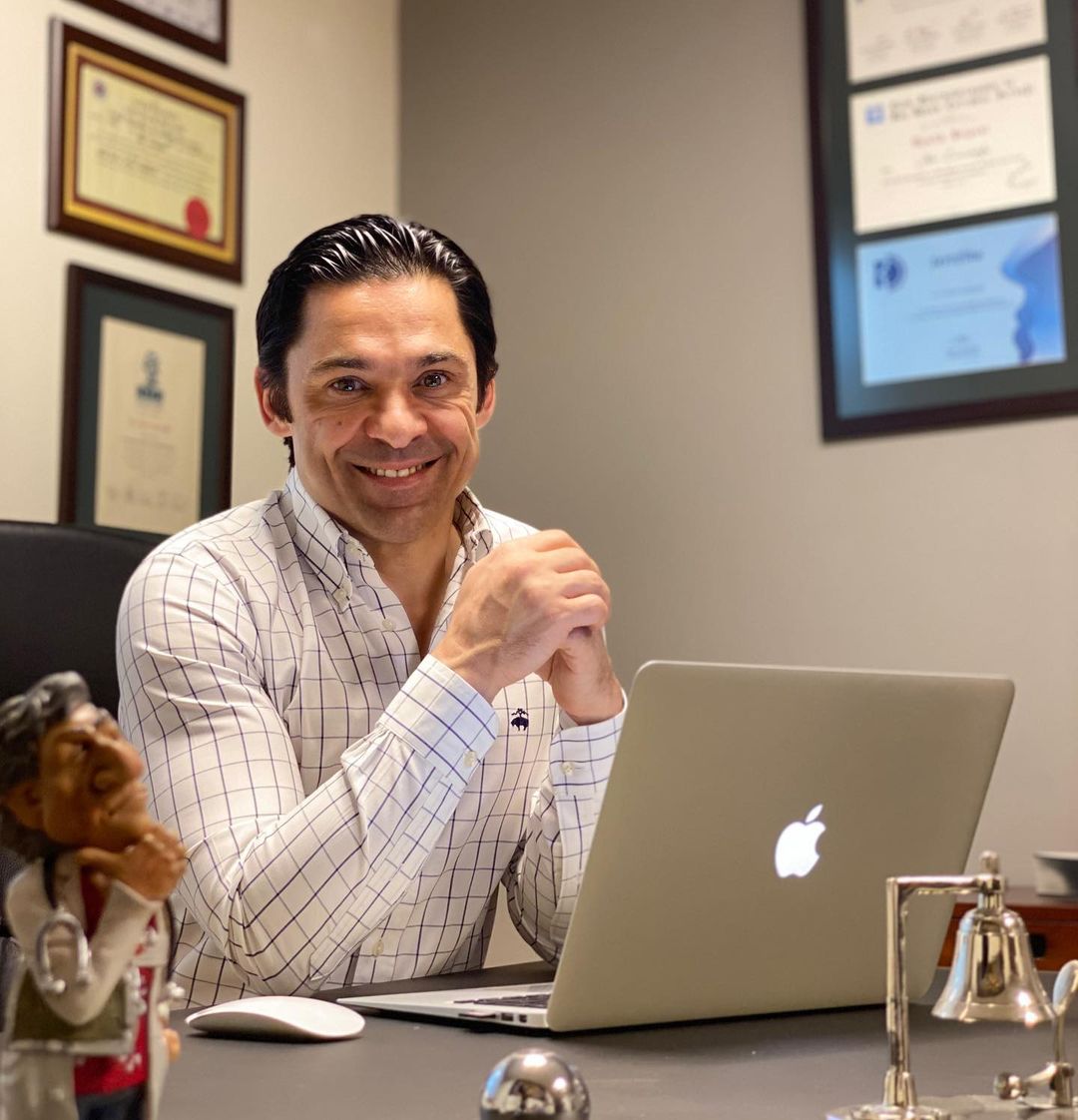
Op. Dr. Alev Camcıoğlu
Rhinoplasty Surgeon
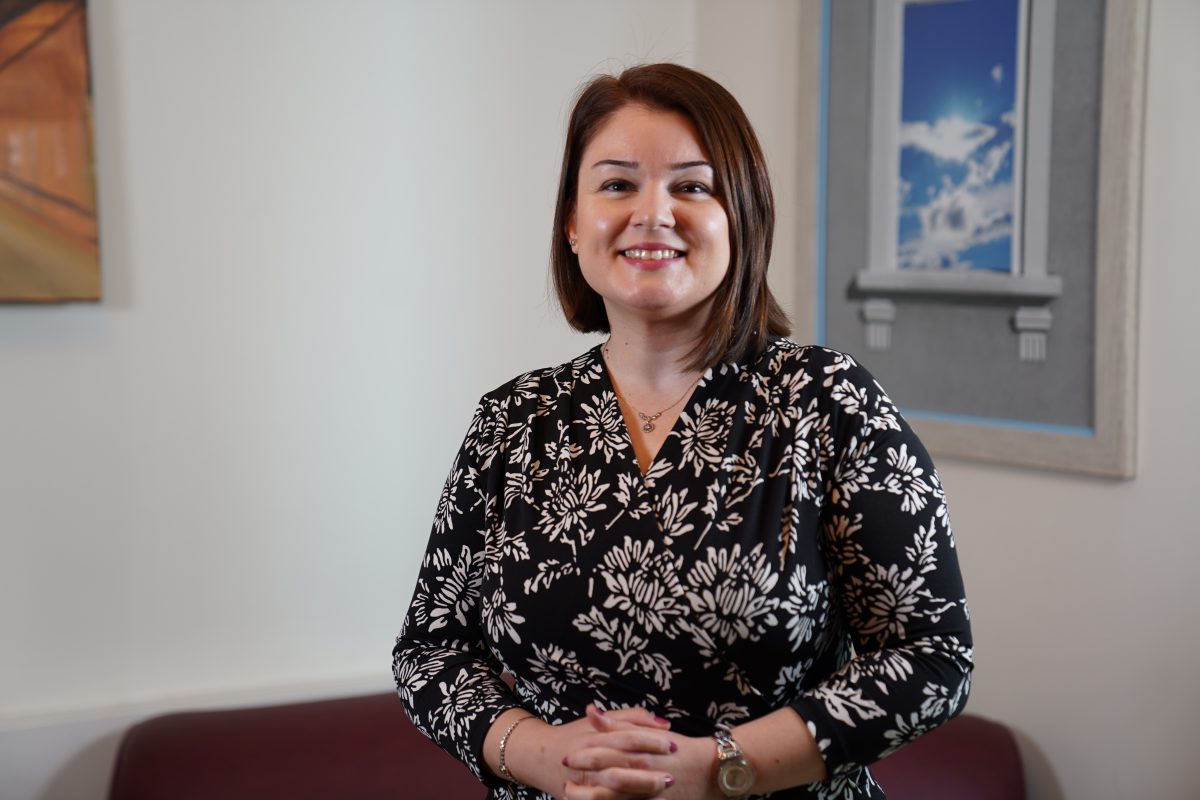
Aylin Uyuşmak
Clinical Coordinator

Serra Sevgili
Clinical Assistant
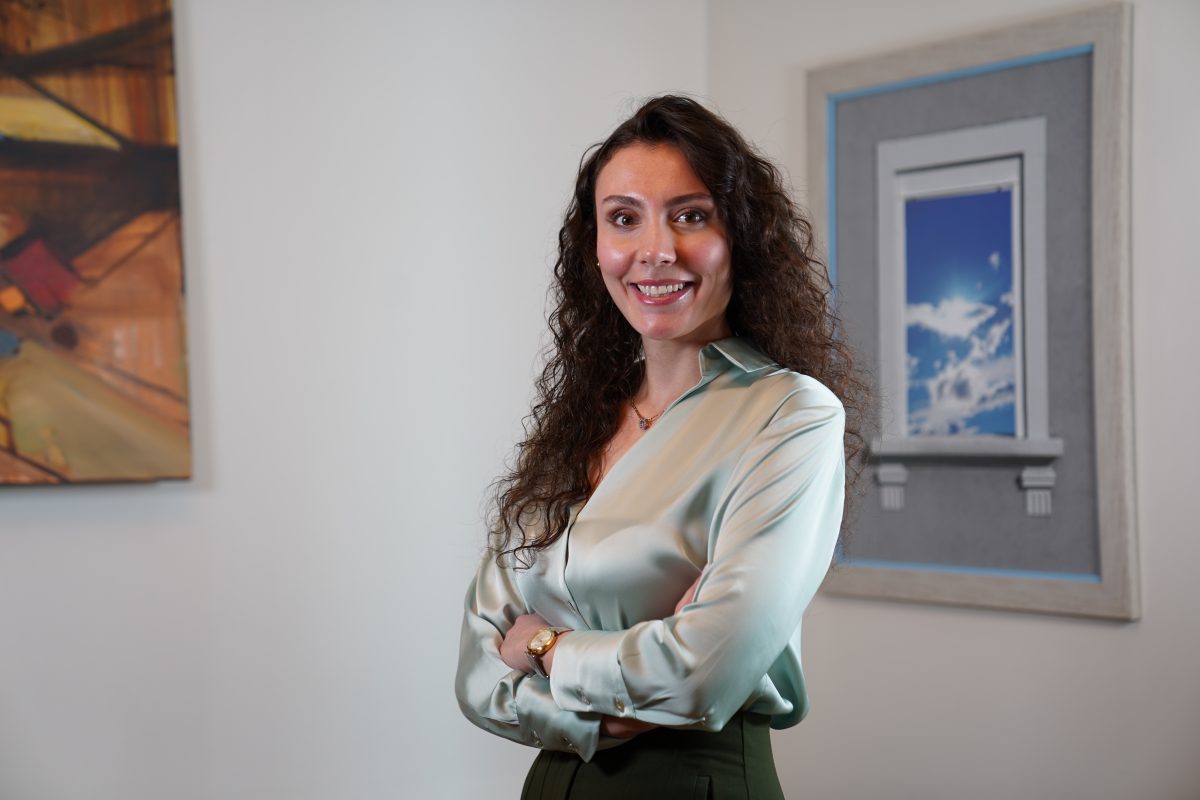
Sema Yapıcı
Operating Room Nurse
